Warm beams of heritage timber, friendly countertop chatter, and the satisfying thud of a chef’s knife on solid wood— few features bring a kitchen to life the way a thoughtfully chosen farmhouse kitchen island can. Beyond its sturdy good looks, the right island anchors workflow, invites conversation, and sneaks in smart storage, all while echoing today’s shift toward tactile, nature-inspired materials. Designers highlight reclaimed boards, mixed-metal accents, and feel-good earthy paints as simple routes to an island that feels collected over time yet fresh enough for 2025.
1. Reclaimed-Wood Farmhouse Kitchen Island Brings Instant Warmth
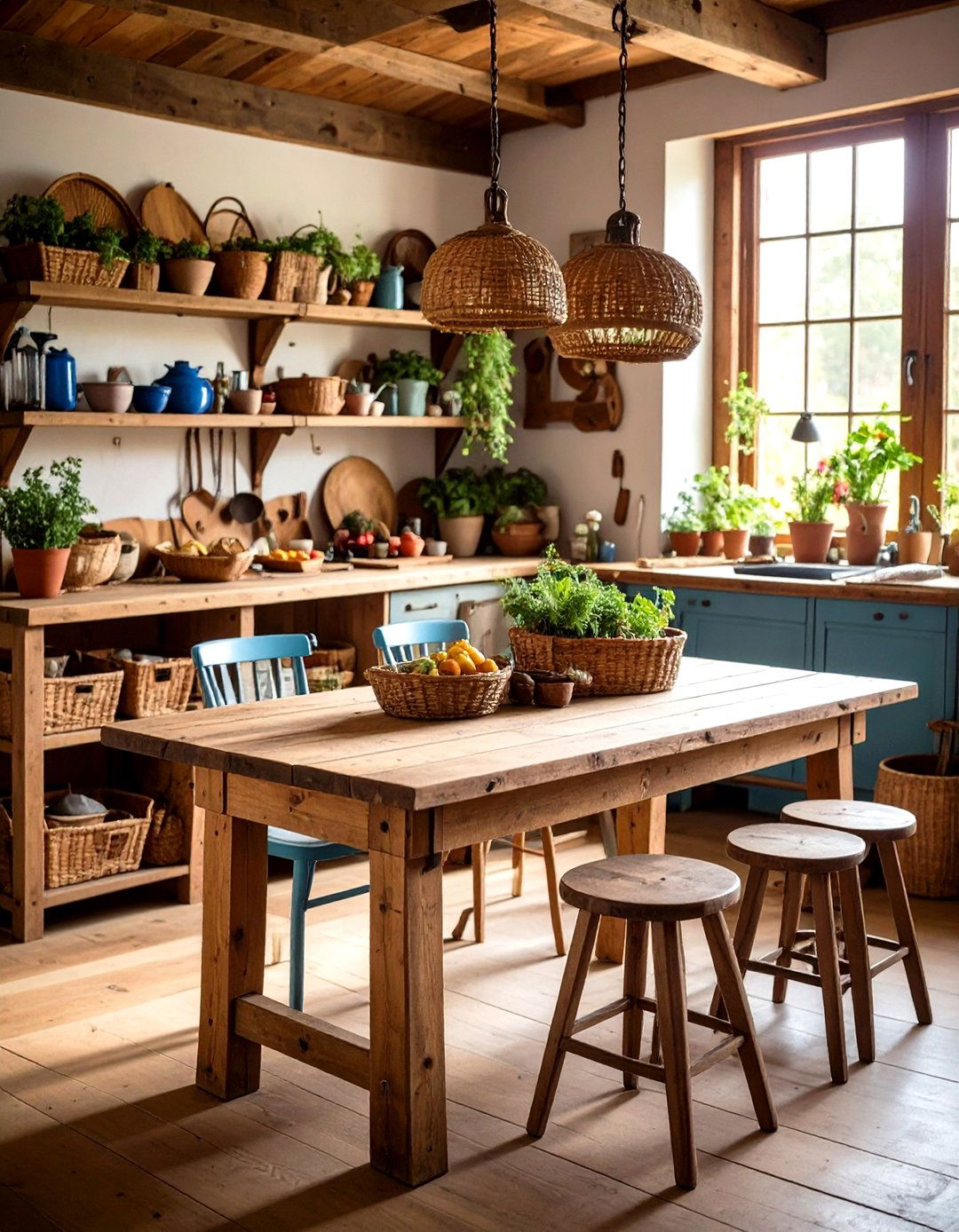
A soothing hush settles over a room the moment weathered planks take center stage, and a reclaimed-wood farmhouse kitchen island does exactly that by weaving history into everyday cooking. The grooves and nail holes in salvage lumber tell stories, but they also mask dings from family life, making maintenance worry-free. Pair the rugged base with a clean quartz top for contrast, or keep the look cohesive with oiled oak. Designers note that reclaimed islands boost resale value thanks to their rare, artisanal character, while sustainable sourcing appeals to eco-minded homeowners. Hidden casters underneath heavy beams make the unit shuffle gently when the floor plan needs to flex. Backsplash
2. Shiplap-Clad Farmhouse Kitchen Island with Butcher-Block Top
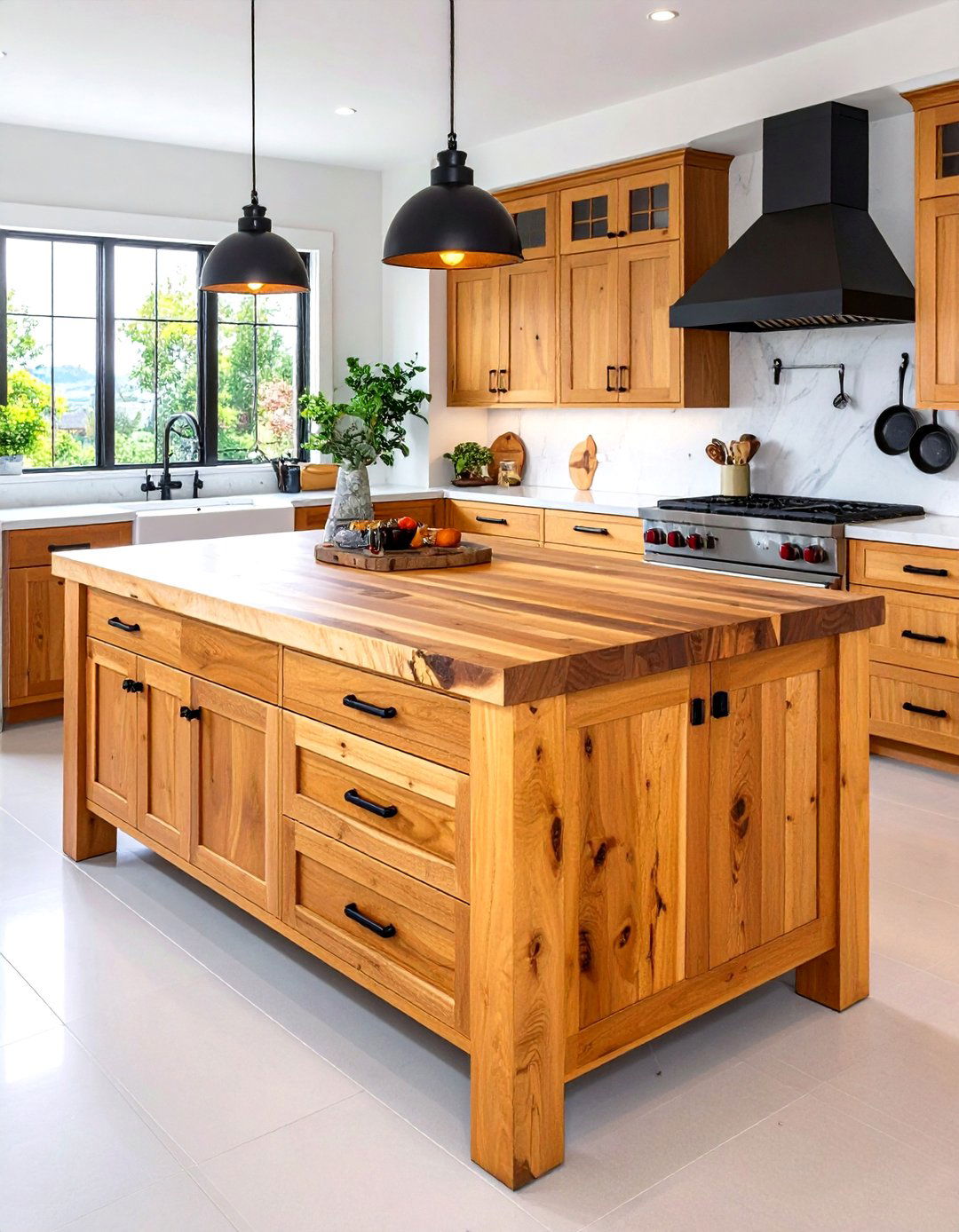
Unlike plain paneling, shiplap wraps a farmhouse kitchen island in rhythmic horizontal lines that shout “country comfort” without crowding the room. Topping the structure with a sealed butcher-block slab creates a hardworking prep zone where bread dough, vegetables, and charcuterie all feel at home. Interior pros love how the block’s natural oils resist bacteria while its warm tone balances the crisp white grooves of shiplap. A light coat of matte sealer keeps saw-cut texture visible yet wipeable after messy projects. Install a breadboard pull-out just beneath the counter to extend workspace on demand—ideal for holiday baking marathons. Pinterest
3. Sage-Green Farmhouse Kitchen Island Adds Fresh Color

Certainly, even the most neutral kitchens perk up when a sage-green farmhouse kitchen island glides in, echoing herb gardens and misty mornings. Paint experts list soft greens among 2025’s top cabinet hues because they soothe the eye while still feeling modern. The shade pairs beautifully with brass pulls or wrought-iron latches, letting you mix metals for a layered look that avoids the “matchy” trap designers now caution against. For extra depth, distress corners lightly so hints of raw pine peek through; the patina keeps the island from looking freshly delivered. Slip wicker baskets onto open shelves below to complete the cottage-garden palette. Country Living The Spruce
4. X-Brace Barn-Door Farmhouse Kitchen Island Maximizes Hidden Storage
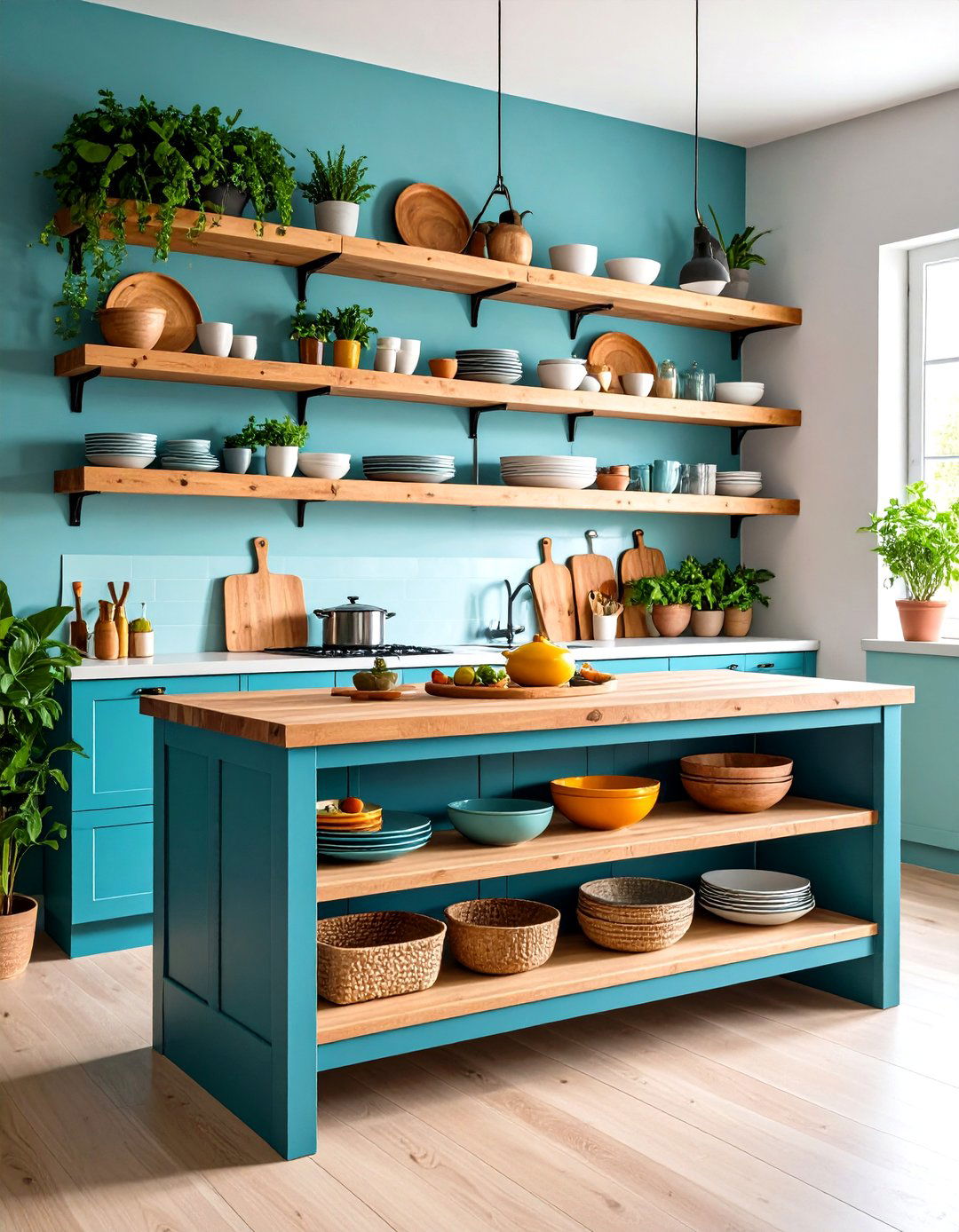
A, the unmistakable X-brace on sliding barn doors instantly stamps a farmhouse kitchen island with barn-loft charisma while concealing countertop clutter. Smooth-glide rollers reveal generous cubbies for mixers, recycling bins, or oversized stockpots—items that usually hijack counter space. Opt for black-powder hardware against sun-washed pine for dramatic contrast, or choose antique zinc for subtler charm. Interior stylists suggest echoing the X motif on the island ends to create a coherent silhouette visible from any angle in open-plan homes. Soft-close dampers keep the doors whisper-quiet during midnight snack runs. Pinterest WoodWorkly
5. Open-Shelving Farmhouse Kitchen Island Showcases Everyday Essentials
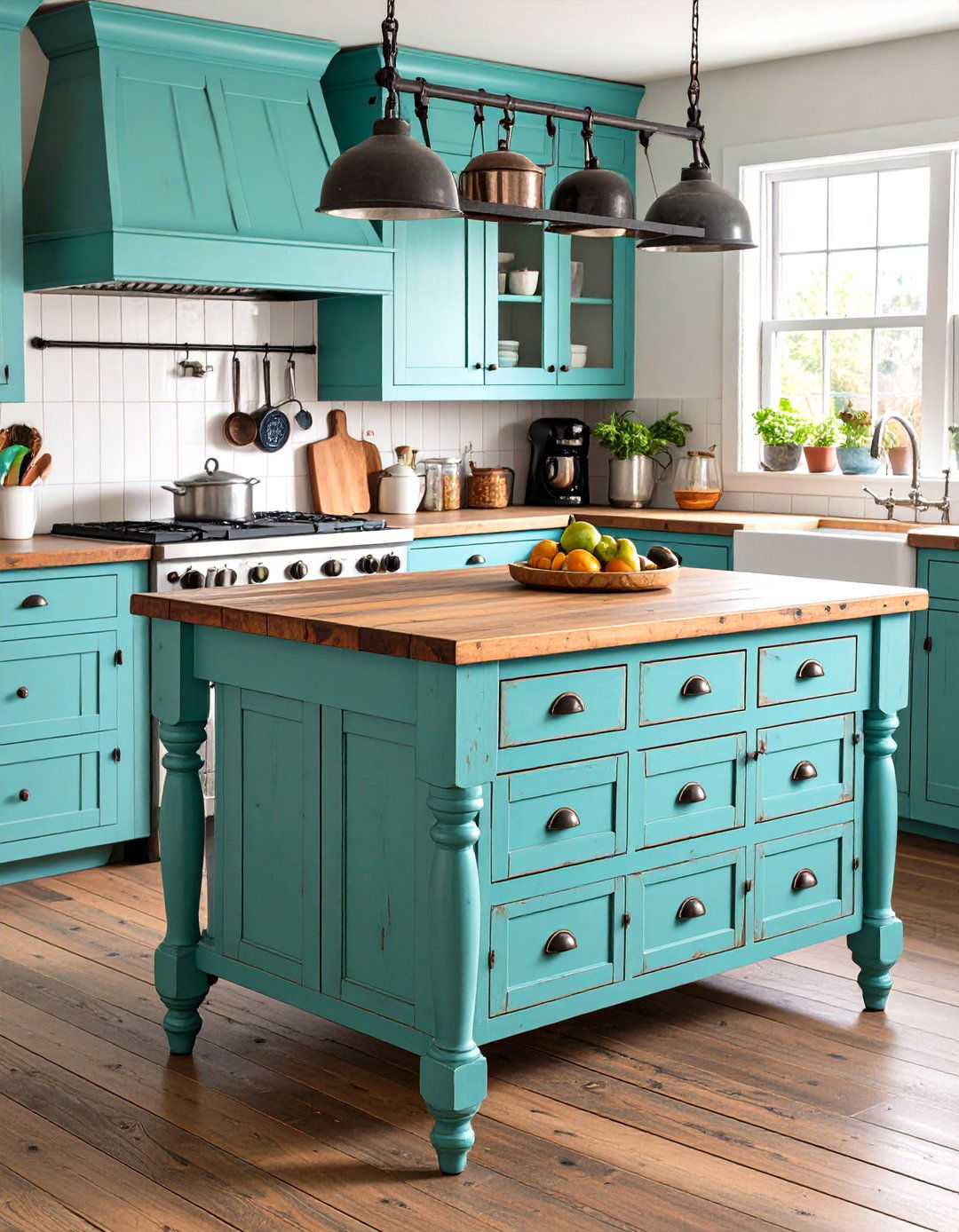
Looking for display room plus easy reach? Open shelving along a farmhouse kitchen island turns plates, cookbooks, and woven bins into casual décor. Designers say removing solid cabinetry visually lightens the footprint—especially vital in modest kitchens—while encouraging owners to curate only what they love. Stack white stoneware, nest copper pans, or line up canisters of grains for a ready-made still-life scene that evolves with seasons. Keep shelves no deeper than twelve inches so items don’t disappear in shadow, and run a bead of clear silicone along wood edges to guard against drips from dish duty above. Pinterest Real Simple
6. Furniture-Style Kitchen Island Flaunts Turned-Leg Charm
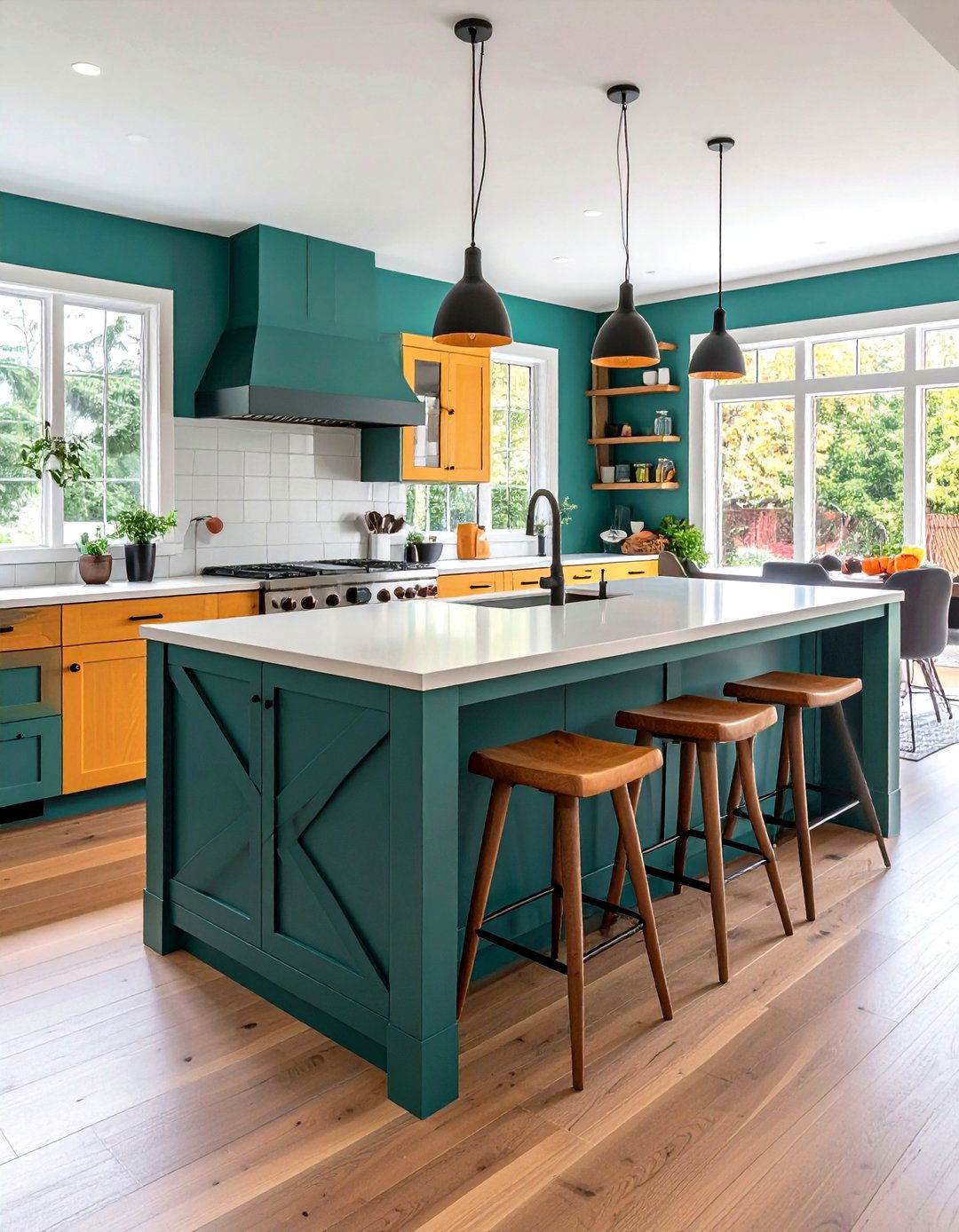
With stately turned legs and a low slatted shelf, this furniture-style farmhouse kitchen island reads more like a beloved antique table than built-in cabinetry. Artisans often craft legs from red oak or maple, then stain them just dark enough to highlight swirl grain patterns. That open base leaves knee-room for stools while keeping pots within reach. Home chefs who bake appreciate how air circulates around cooling racks placed on the lower shelf, avoiding soggy crusts. Add discreet casters beneath each leg—hidden by decorative ferrules—to retain the silhouette yet gain mobility for deep-clean days. Homes & Gardens
7. Butcher-Block-Topped Farmhouse Kitchen Island Doubles as Cutting Board
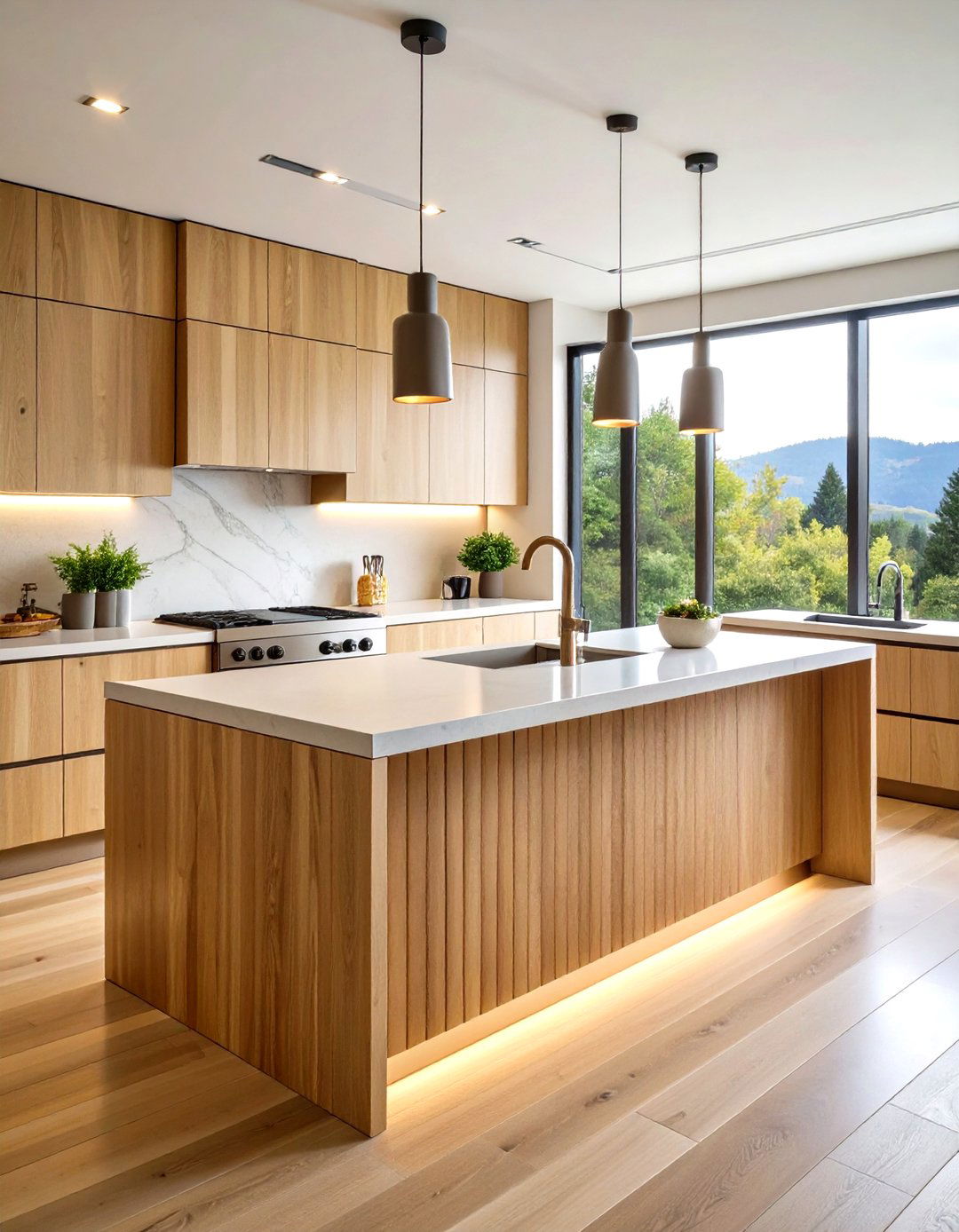
Surprisingly, a hefty butcher-block countertop transforms a farmhouse kitchen island from mere storage unit into the most forgiving prep surface in the house. End-grain boards shrug off knife marks, and any scuffs buff away with fine sandpaper followed by food-safe mineral oil. Studies on countertop durability reveal that properly maintained butcher block can outlast two decades of daily use without cracking, making it a economical long-haul choice for busy households. Warm maple hues also temper the coolness of stainless appliances, weaving the space together visually. Incorporate a trash chute cut-out to sweep peelings straight into a hidden bin below. HomeGuide
8. Vintage Workbench Reimagined as Farmhouse Kitchen Island
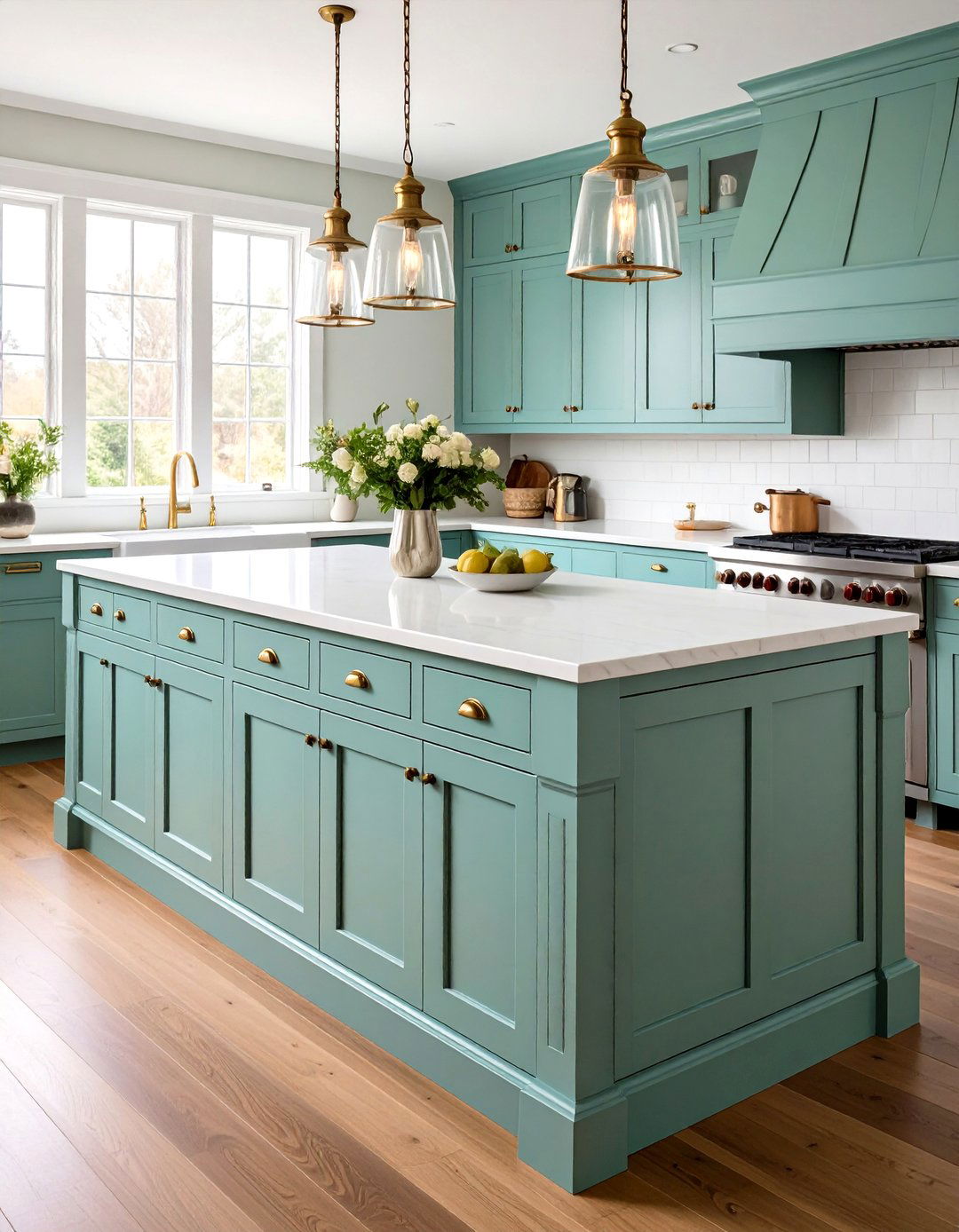
For those drawn to storied pieces, repurposing a vintage workbench into a farmhouse kitchen island layers authenticity you simply can’t fake. Decades-old vises can be removed or converted into clever towel bars, while the scarred top gains newfound glory under food-grade wax. Owners of such islands often report unexpected conversation starters during gatherings, as guests ask about each dent and paint splatter. To ensure height matches modern counters, installers typically add locking casters or a plinth before sealing any lingering oil stains with shellac. The result is a soulful centerpiece that balances modern appliances with raw history. Jennifer Rizzo
9. Rolling Farmhouse Kitchen Island on Wheels Offers Layout Freedom
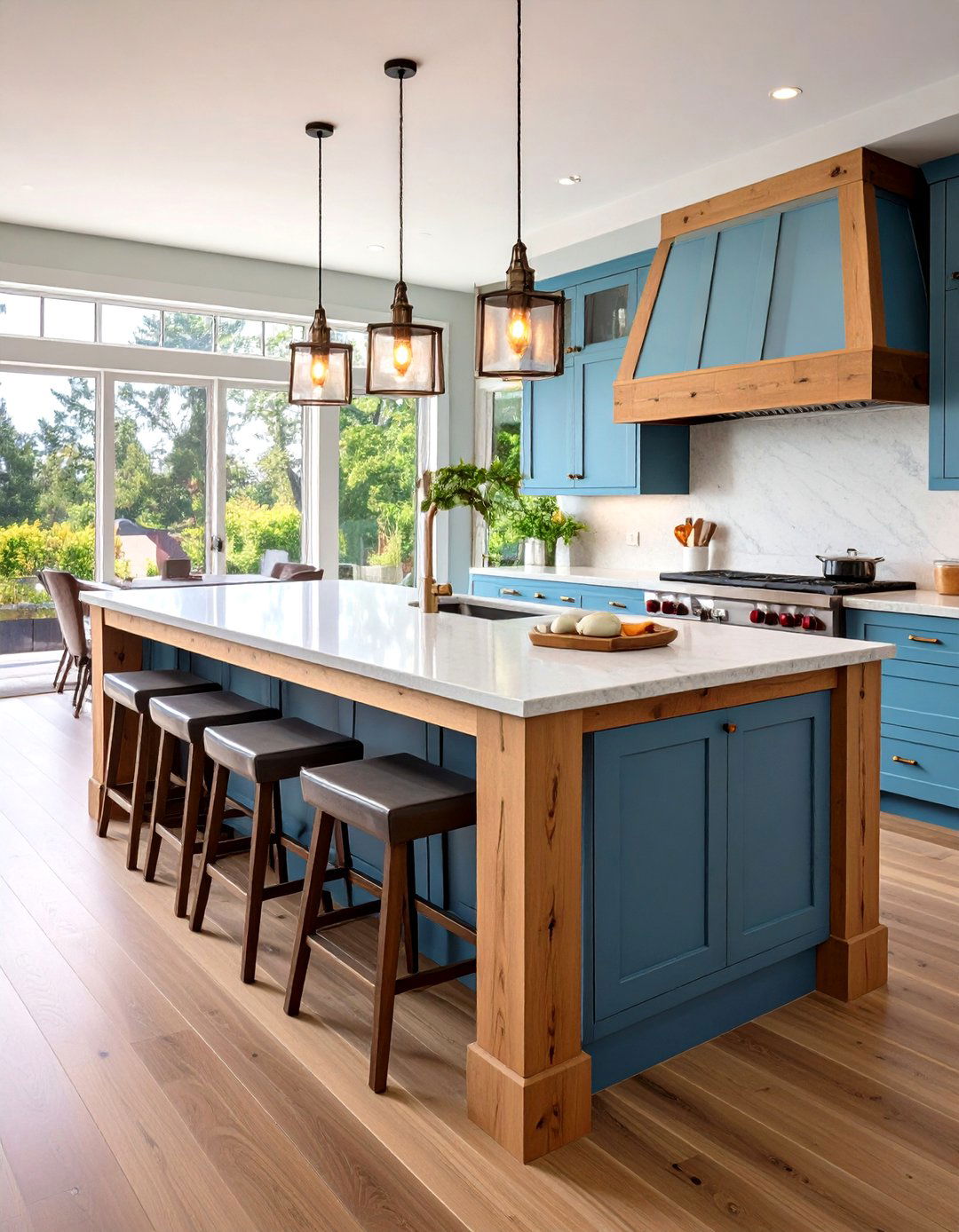
Consider the convenience of a rolling farmhouse kitchen island when your space must juggle homework, holiday buffets, and meal prep. Locking industrial casters rated for at least 300 lbs let the island glide to the wall for dance-floor room or park beside the stove as an impromptu sous-chef station. Models with barn-door fronts and interior refrigerator-style racks keep condiments organized yet portable for patio dinners. Add a drop-leaf extension that flips up for extra seating, then folds to free pathways. Rubber-tread wheels protect reclaimed floors while ensuring silent movement across tile or wood. Pinterest
10. Beadboard-Panel Farmhouse Kitchen Island Lends Cottage Calm
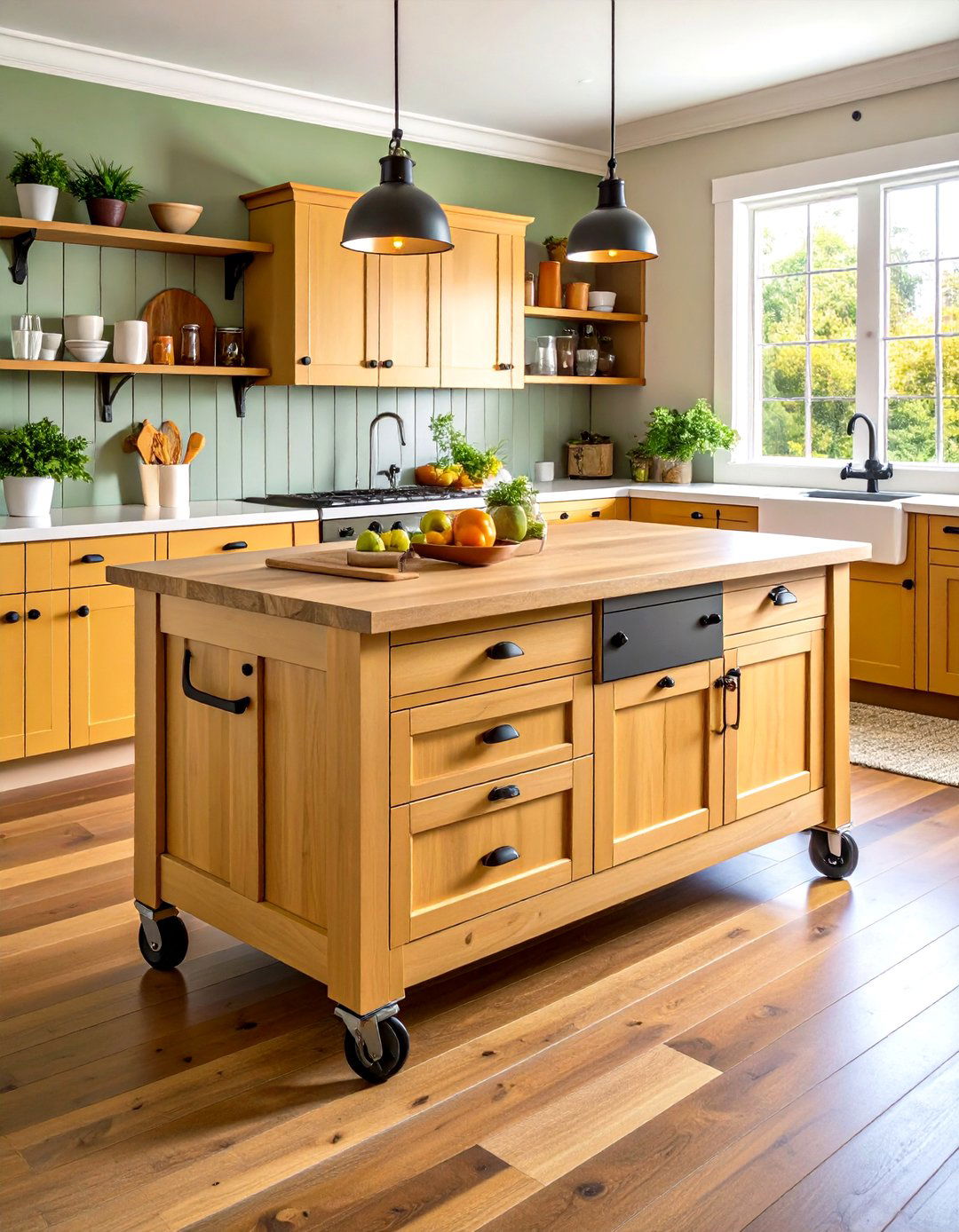
As research on timeless millwork shows, beadboard never truly leaves the style conversation, and wrapping a farmhouse kitchen island in these vertical grooves cultivates quaint cottage appeal. Painted muted cream or dove gray, the paneling disguises scuffs thanks to its shadow lines while reflecting ambient light to brighten prep zones. Designers often top beadboard islands with gently rounded marble edges to juxtapose soft stone against crisp lines. Decorative corbels beneath the counter echo classic porch brackets, reinforcing the vacation-home mood. A single coat of satin polyurethane shields panel recesses from spaghetti-sauce splatter without adding unwelcome gloss. Casta Cabinetry Pinterest
11. Industrial Farmhouse Kitchen Island Mixes Wood and Metal for Grit
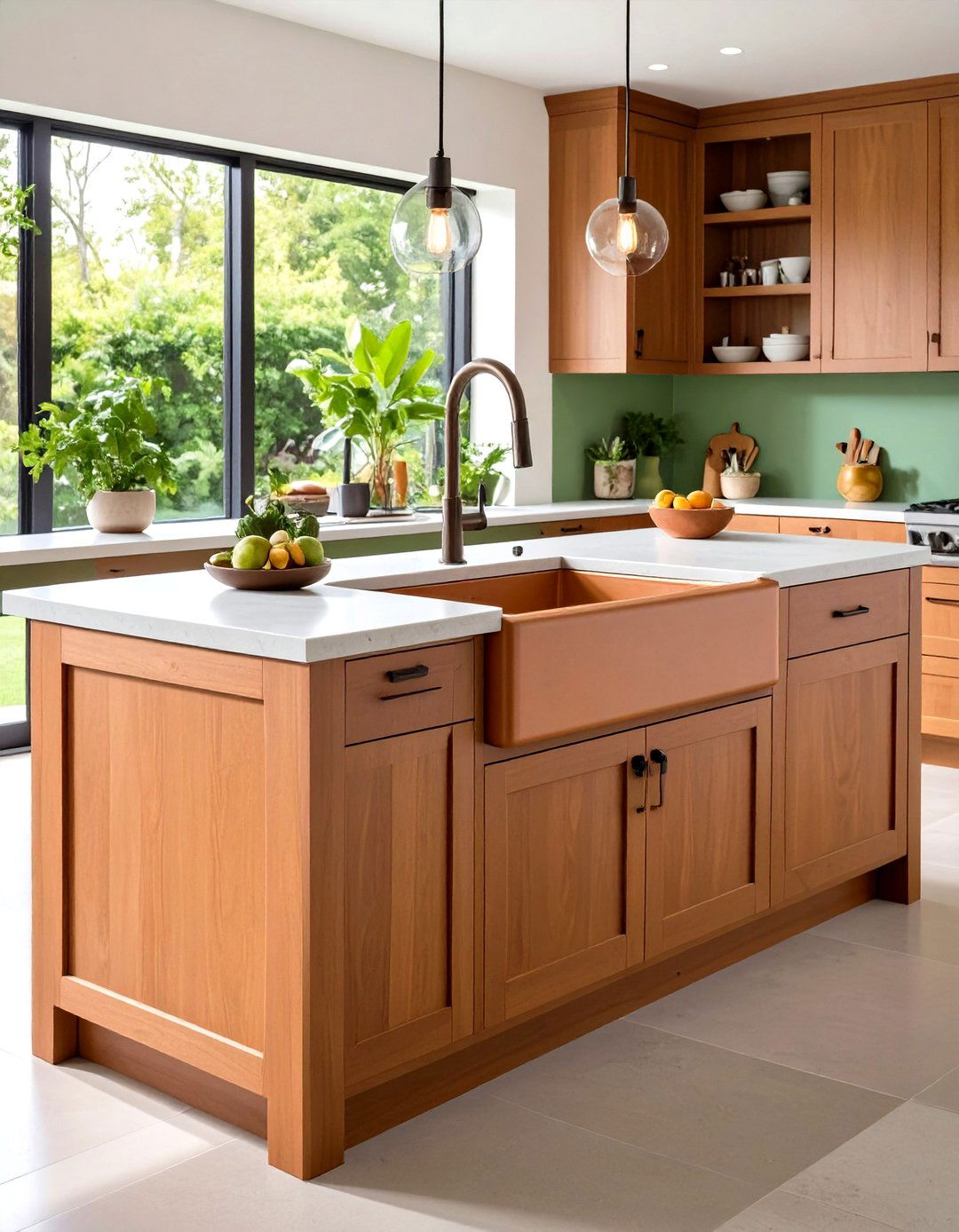
Unlike all-wood builds, an industrial farmhouse kitchen island introduces iron struts, riveted brackets, or galvanized sheet ends that push rustic style toward edgy sophistication. Experts now recommend mixing metal finishes—such as black matte stools with brushed-brass pulls—to sidestep the uniform-hardware look that can date a space. A thick acacia slab anchors the industrial vibe, while open steel mesh shelves stash Dutch ovens without blocking view lines. Optional pot rails welded along the short end free cabinet space above. Edison-bulb pendants overhead carry the factory mood further while washing prep zones in warm light. Pinterest The Spruce
12. Seating-Friendly Kitchen Island Boasts Generous Overhang
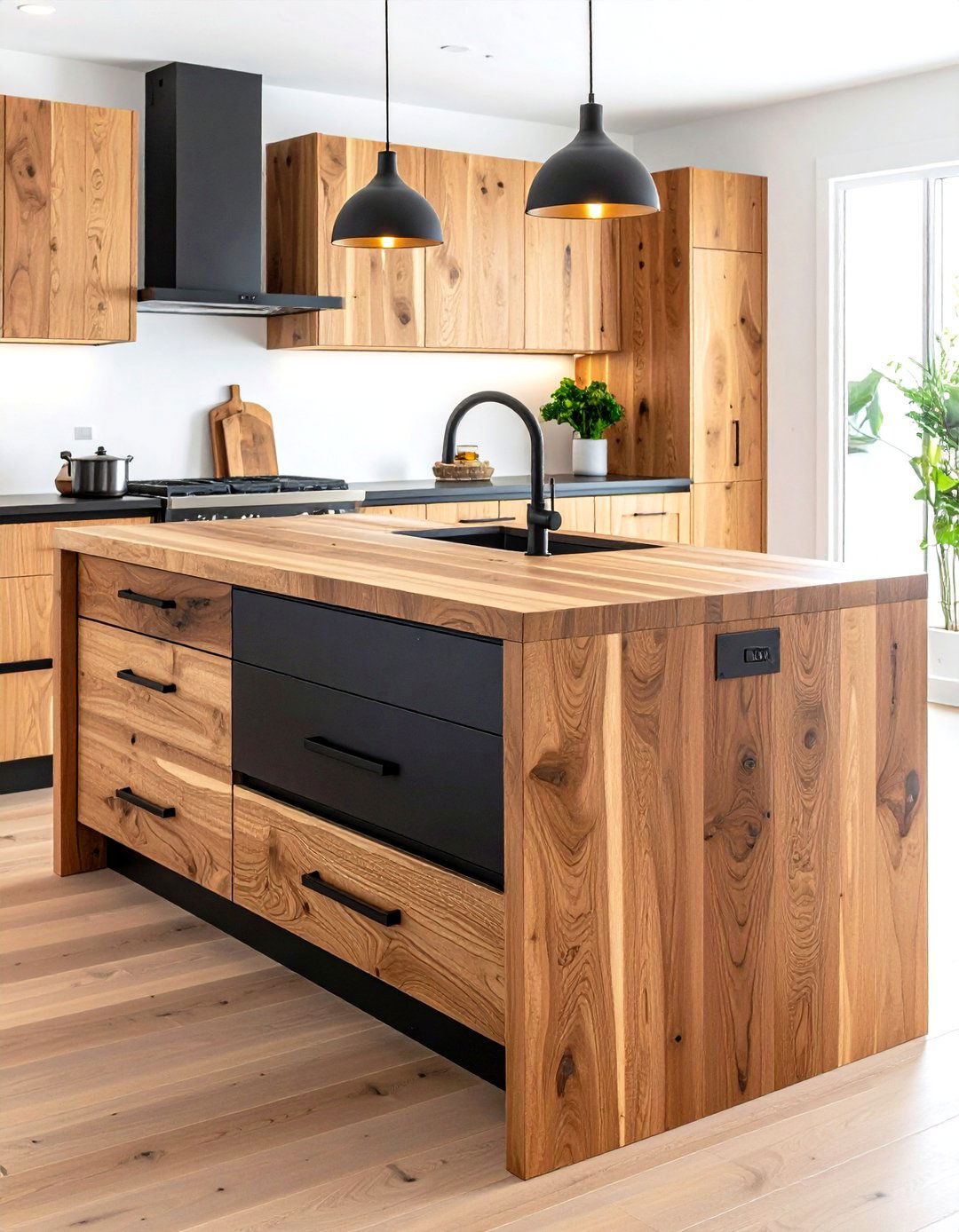
Owing to clever countertop engineering, extending a farmhouse kitchen island’s top by 12–15 inches invites comfortable perch-and-chat sessions without knee-crunching. Designers specify sturdy hidden brackets or decorative legs to bear the cantilevered weight, ensuring safety during lively family brunches. Clearance guides suggest 10–12 inches of overhang for bar-height stools and up to 18 inches for taller occupants to avoid bruised shins. Matching stool heights of about 30 inches lets diners tuck neatly beneath when not in use, keeping walkways clear. Finish the underside with beadboard to maintain the cohesive farmhouse look even at eye level. Dura Supreme Cabinetry Atlantic Shopping
13. Slimline Farmhouse Kitchen Island Solves Tight-Quarters Dilemmas
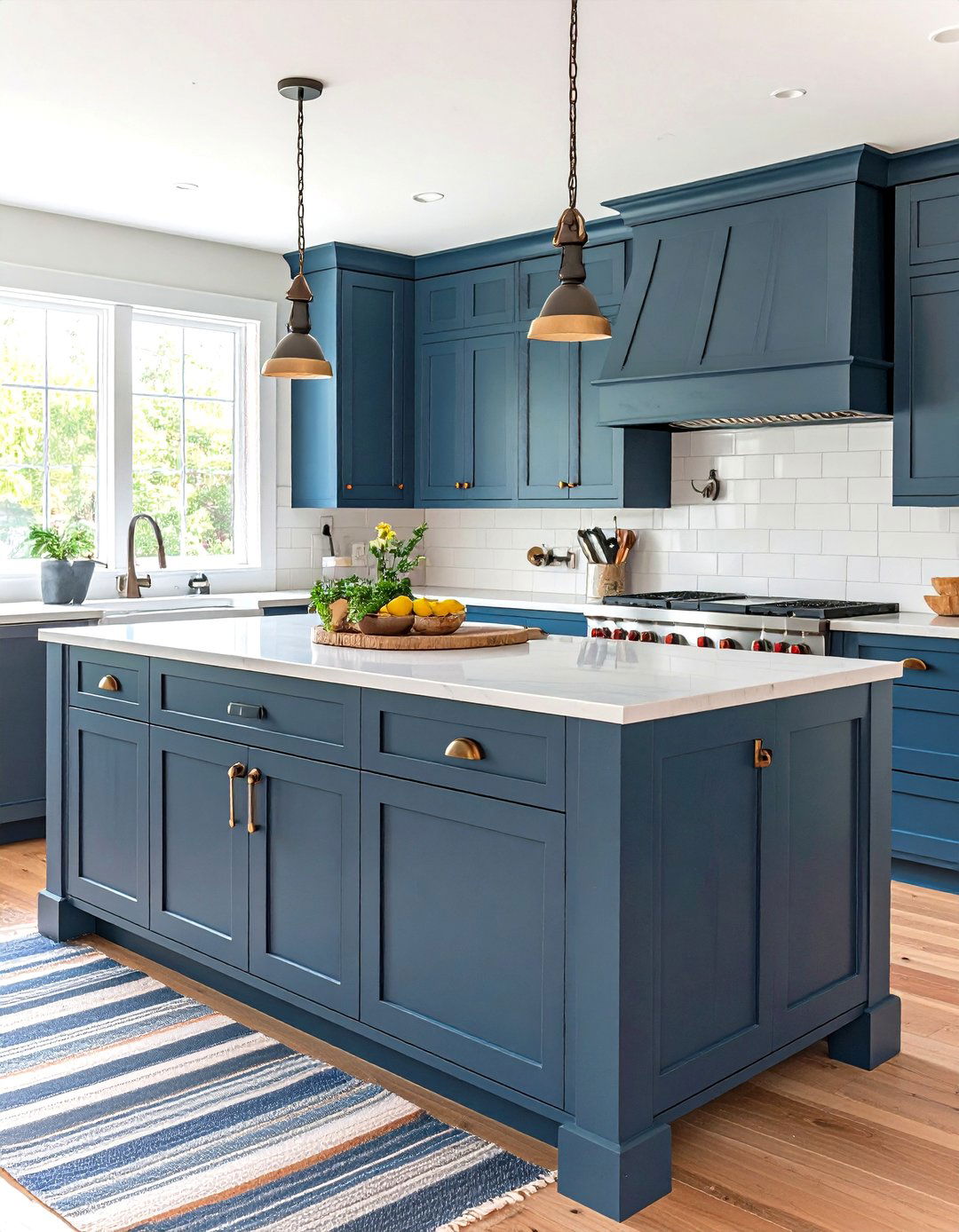
Take heart, galley-kitchen owners: a slimline farmhouse kitchen island just 16–20 inches deep can deliver prep space, storage, and style without suffocating circulation paths. Experts advising compact remodels recommend repurposed console tables or narrow butcher-block carts that allow at least 42 inches of clearance on busy sides. Light finishes such as chalky white or pale gray bounce daylight around and visually widen the footprint. Open slatted shelves below help dishes breathe and eliminate bulky cabinet doors that swing into walking lanes. A mounted rail on the far end holds ladles, saving drawer space and keeping utensils handy. Ideal Home
14. Two-Tone Farmhouse Kitchen Island Highlights Natural Contrast
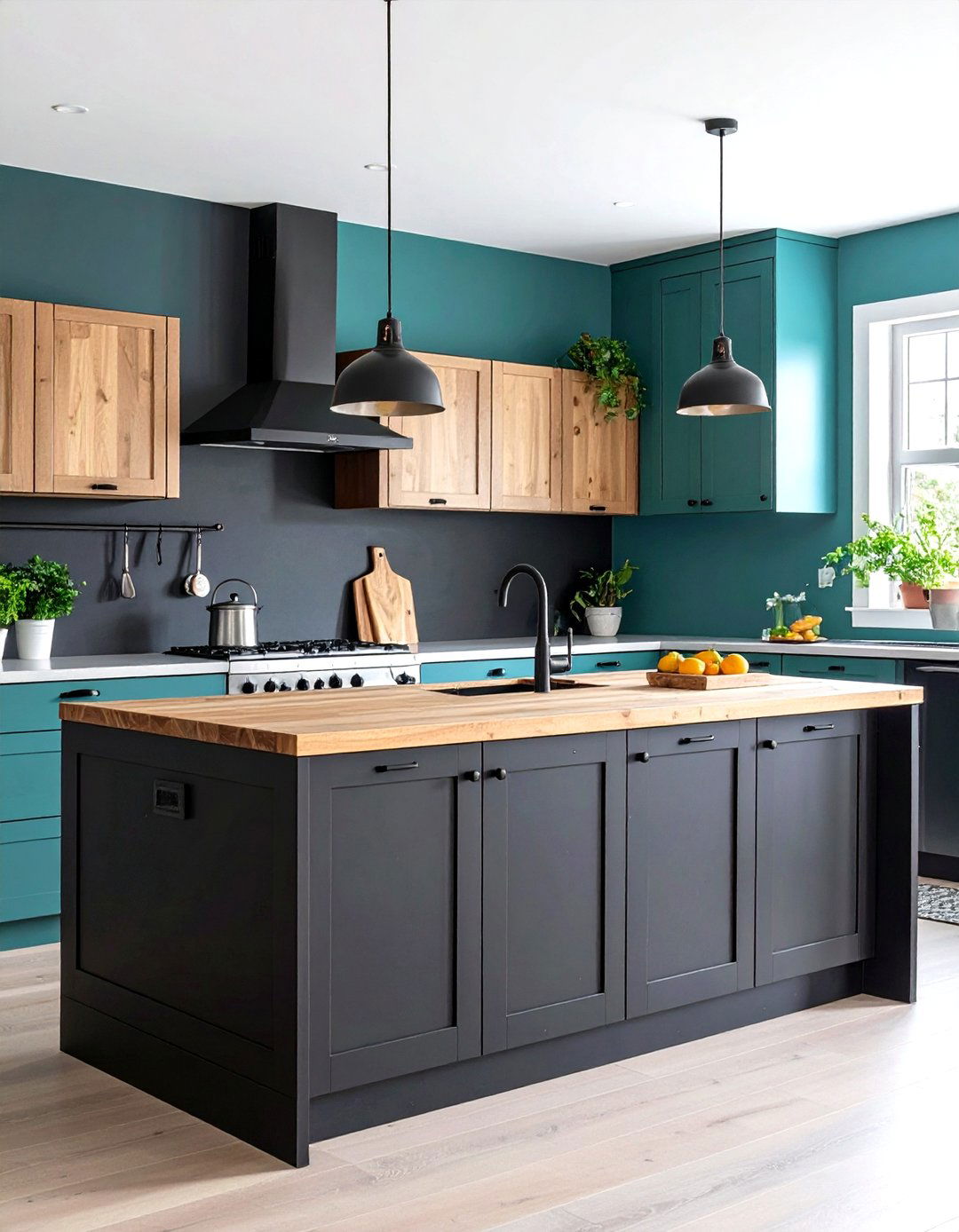
Bringing depth to uniform cabinetry, a two-tone farmhouse kitchen island paints the base a moody hue—think midnight blue or charcoal—while leaving the butcher-block top honey-warm. This color blocking frames the work surface, guiding eyes right where action happens and spotlighting plate presentation during parties. Trend trackers note that pairing bold basements with light countertops is a subtle way to test adventurous color without committing wall-to-wall. Repeat the island shade on a small accent, like a range hood stripe or pantry door, to weave cohesion across the room. Sealed mineral-oil finishes on wood tops protect against wine spills without muting grain. RenoAssistance Country Living
15. Power-Ready Farmhouse Kitchen Island Keeps Gadgets in Reach

For, messy extension cords draped across floors become history once a farmhouse kitchen island hides pop-up outlets or side-mounted power strips. Today’s code-compliant modules include USB-C ports alongside standard plugs, letting you blitz blender smoothies or charge tablets while reading recipes. Place outlets beneath the overhang for discreet access that won’t intrude on aesthetic lines. Some ready-made islands integrate sliding barn-door cabinets with appliance garages, neatly parking stand mixers behind ventilated panels after use. Remember to work with a qualified electrician to route wiring through the floor and provide a dedicated 20-amp circuit for heavy-duty gadgets. Amazon
16. Rustic Stone-Top Farmhouse Island Marries Texture and Durability
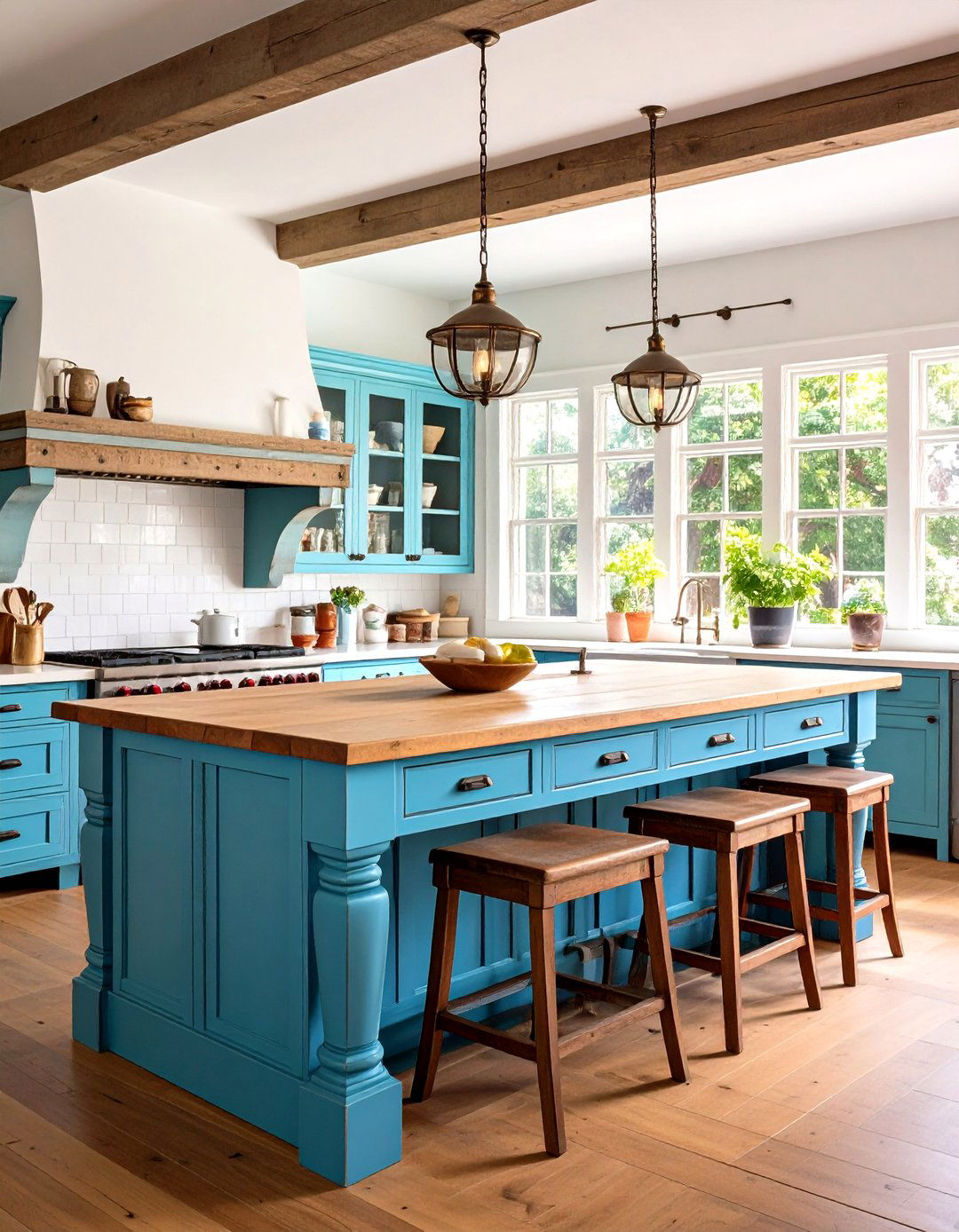
Despite the dominance of wood, pairing a chunky reclaimed-pine base with a honed soapstone or concrete top gives a farmhouse kitchen island unmatched tactile contrast and resilience against hot pans. Soapstone darkens gracefully with oiling, complementing time-worn beams, while concrete can be tinted warm taupe to mimic river silt. Designers advise sealing both materials annually to fend off citrus etching or wine rings. The cool surface is a baker’s dream for pastry work, yet rock-solid mass keeps the island from shifting during bread-kneading vigor. Exposed aggregate edges lend rugged authenticity echoing barn foundations. Better Homes & Gardens
17. Apron-Sink Integrated Farmhouse Kitchen Island Streamlines Prep
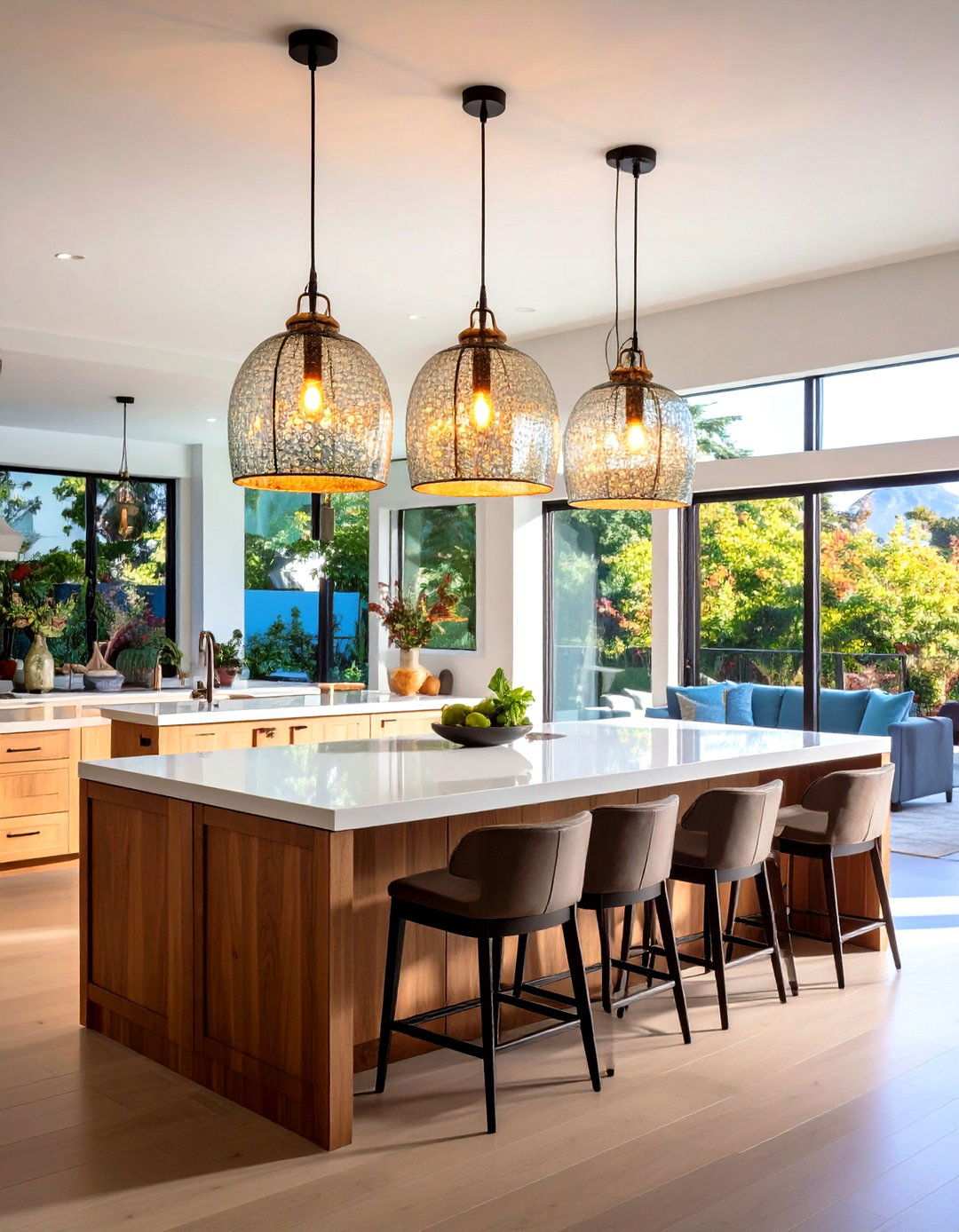
With, an apron-front sink dropped into the farmhouse kitchen island, rinsing herbs and draining pasta happen without back-and-forth dashes to the perimeter. The deep basin hides cookie sheets, sparing countertops from clutter, while its exposed face adds another layer of nostalgic charm. Water-resistant cabinet interiors clad in marine-grade plywood protect storage from splash zones. Pair the sink with a pull-down bridge-style faucet in aged brass to continue the farmhouse narrative and tie in mixed metals from surrounding hardware. Installing a garbage disposal beneath further condenses cleanup into one efficient command center.
18. Statement Lighting Crowns the Farmhouse Kitchen Island
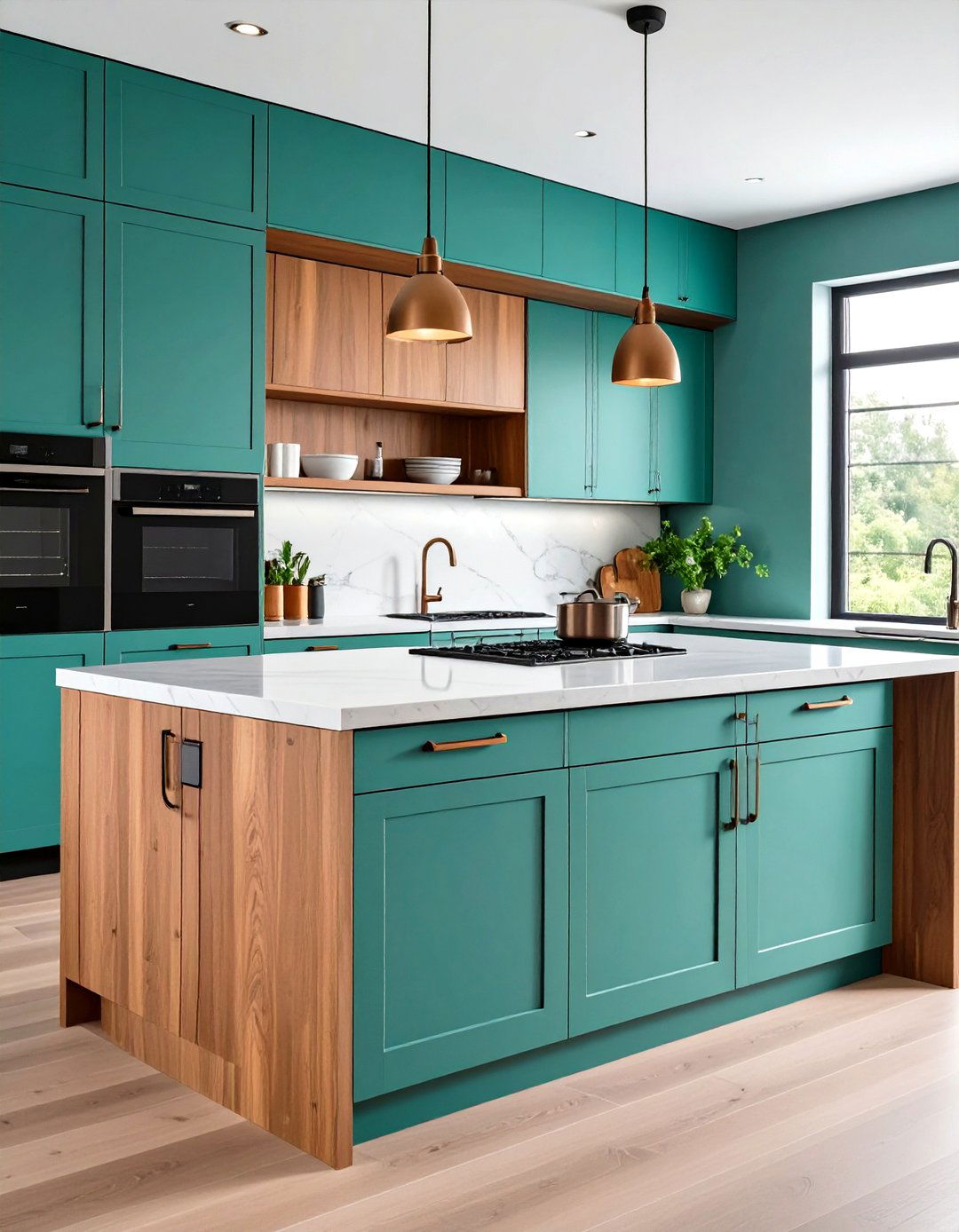
Shortly after installing a farmhouse kitchen island, homeowners often realize a trio of pendant lights can make or break the ambience. Trend watchers highlight open-metal shades with seeded glass that scatter cozy patterns across butcher-block tops. Height matters: suspend fixtures 30–34 inches above the counter to avoid head bumps while keeping illumination focused. Smart dimmers shift moods from brisk breakfast prep to candlelit dessert sharing. Match bulb color temperature (around 2700 K) to enhance the warm undertones of wood and keep food looking appetizing. When the island isn’t in use, the lighting cluster becomes a sculptural focal point. RenoAssistance
19. Distressed-Paint Finish Kitchen Island Evokes Time-Worn Character
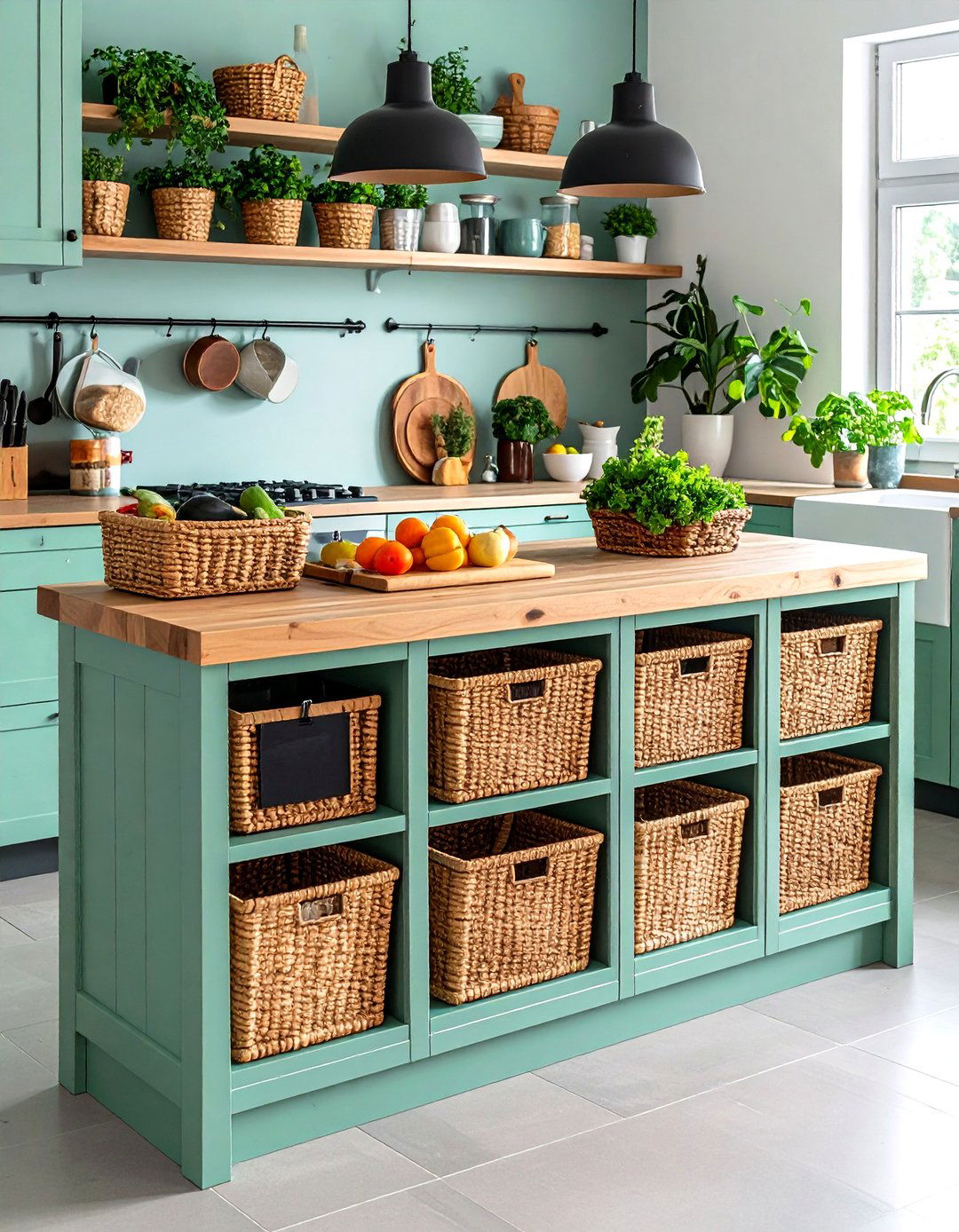
Owing to gentle sanding and wax layering, a distressed-paint farmhouse kitchen island conjures memories of heirloom sideboards without the antique-shop price tag. Chalk-style paints allow easy scuffing along edges, especially on raised panels and turned legs where natural wear would concentrate. Seal the surface with matte polycrylic to lock in patina yet repel spaghetti sauce. Interior stylists caution against over-distressing; a few thoughtfully rubbed corners convince the eye, while excessive chipping can slip into shabby chic cliché. Contrast the textured base with gleaming hardware for a balanced old-meets-new statement. Better Homes & Gardens
20. Antique Table Replacement Creates a Freestanding Kitchen Island
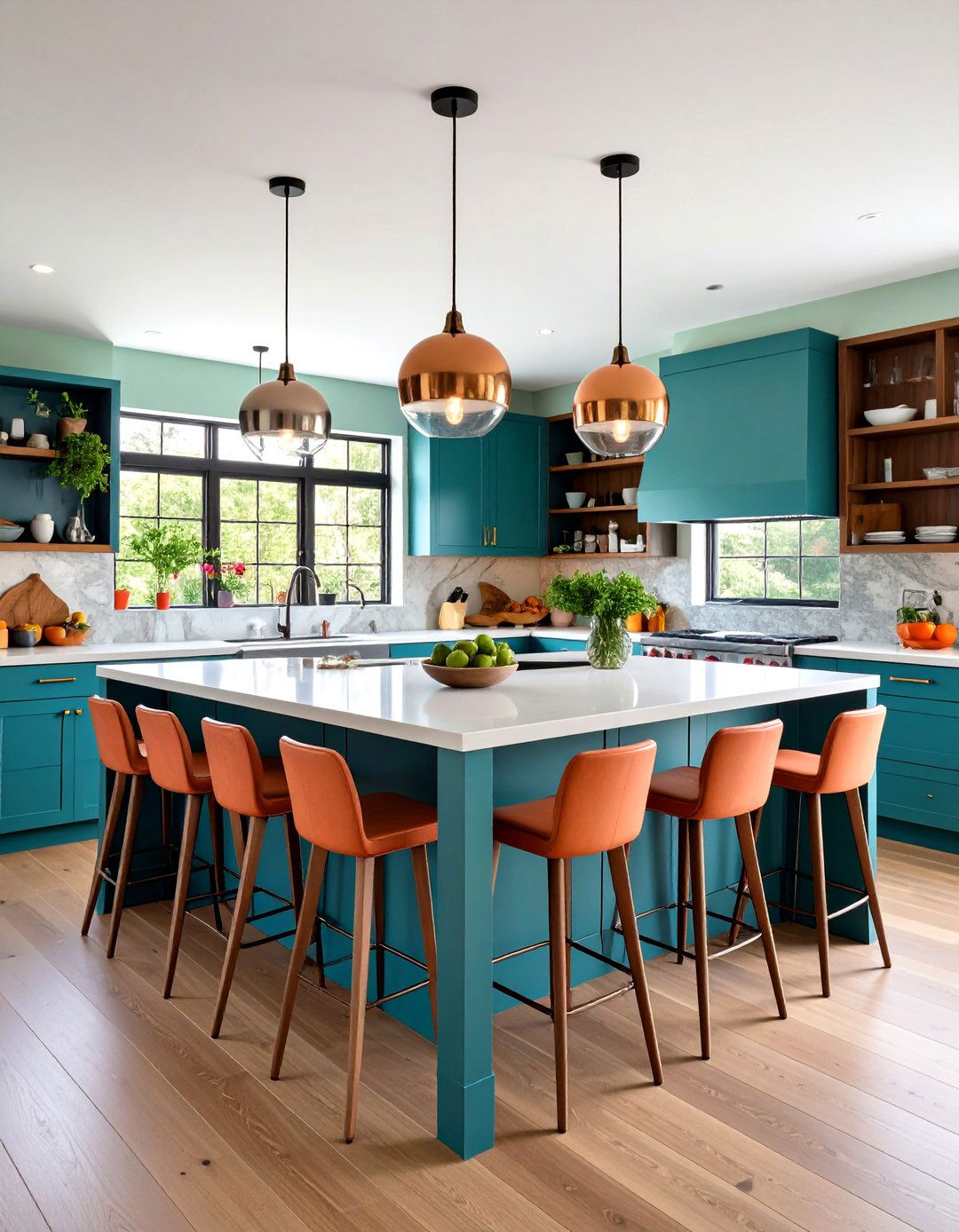
Finally, swapping a standard built-in for an antique farm table resurrects the convivial spirit of traditional sculleries. The open legs allow floor vents to breathe, and you can slide lightweight stools under either long side—no awkward supports to dodge. Designers tout this solution for kitchens that might one day revert to a spacious dining zone, because the table can relocate with ease. Protect the historic top with a pane of tempered glass cut to size, leaving the weathered character visible while ensuring sanitation for food prep. Felt pads on feet prevent scratches as the piece shifts for seasonal gatherings. Country Living
Conclusion:
Farmhouse kitchen islands thrive on texture, honest materials, and useful details that meet modern life head-on. Whether you’re reclaiming rugged beams, layering beadboard, or wiring hidden chargers, each idea above proves an island can be both hardworking and heartwarming. Embrace mixed metals, gentle greens, and thoughtful overhangs to craft a centerpiece that welcomes quick weekday breakfasts and lingering midnight chats alike—keeping the warm soul of farmhouse style alive in every meal.


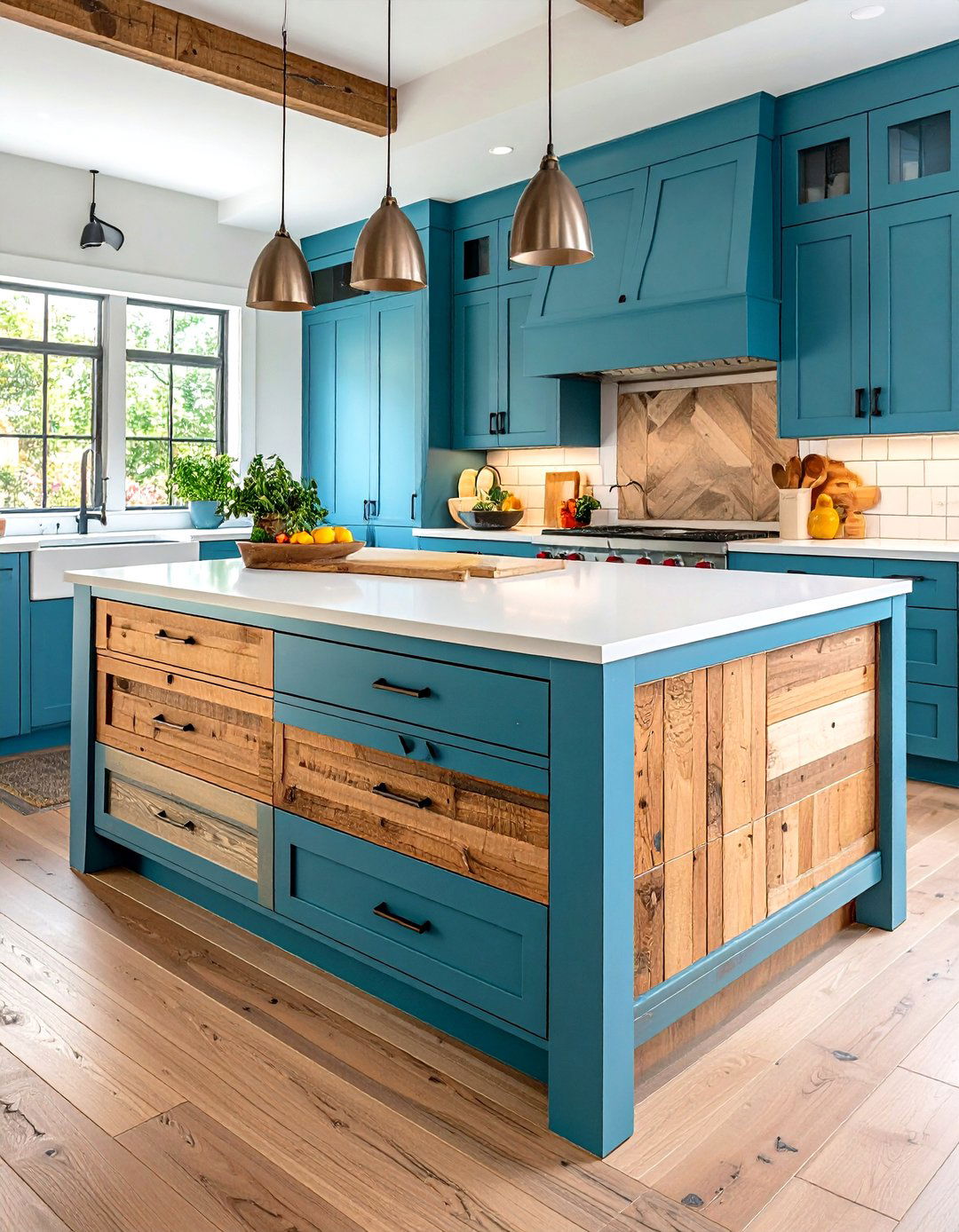

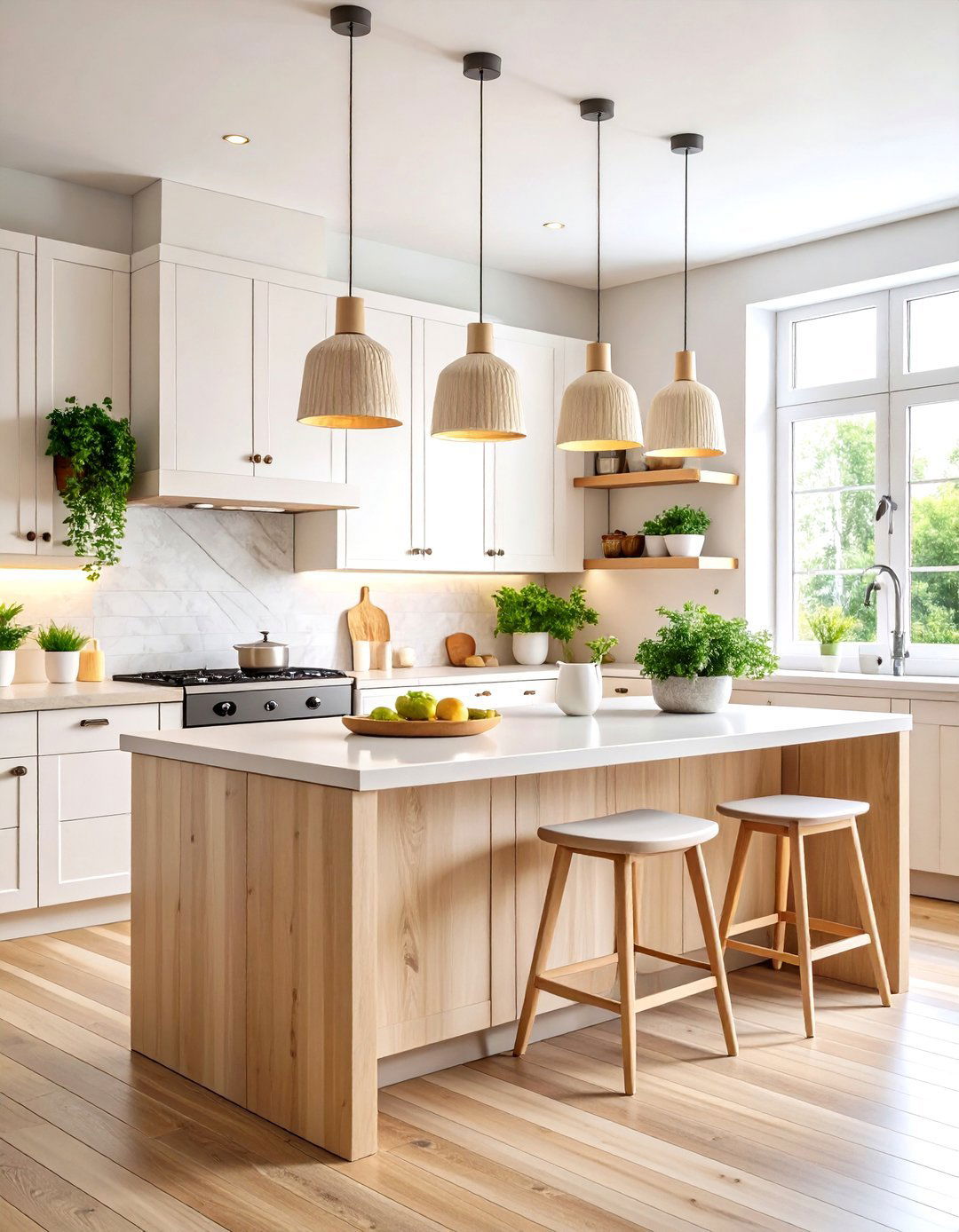
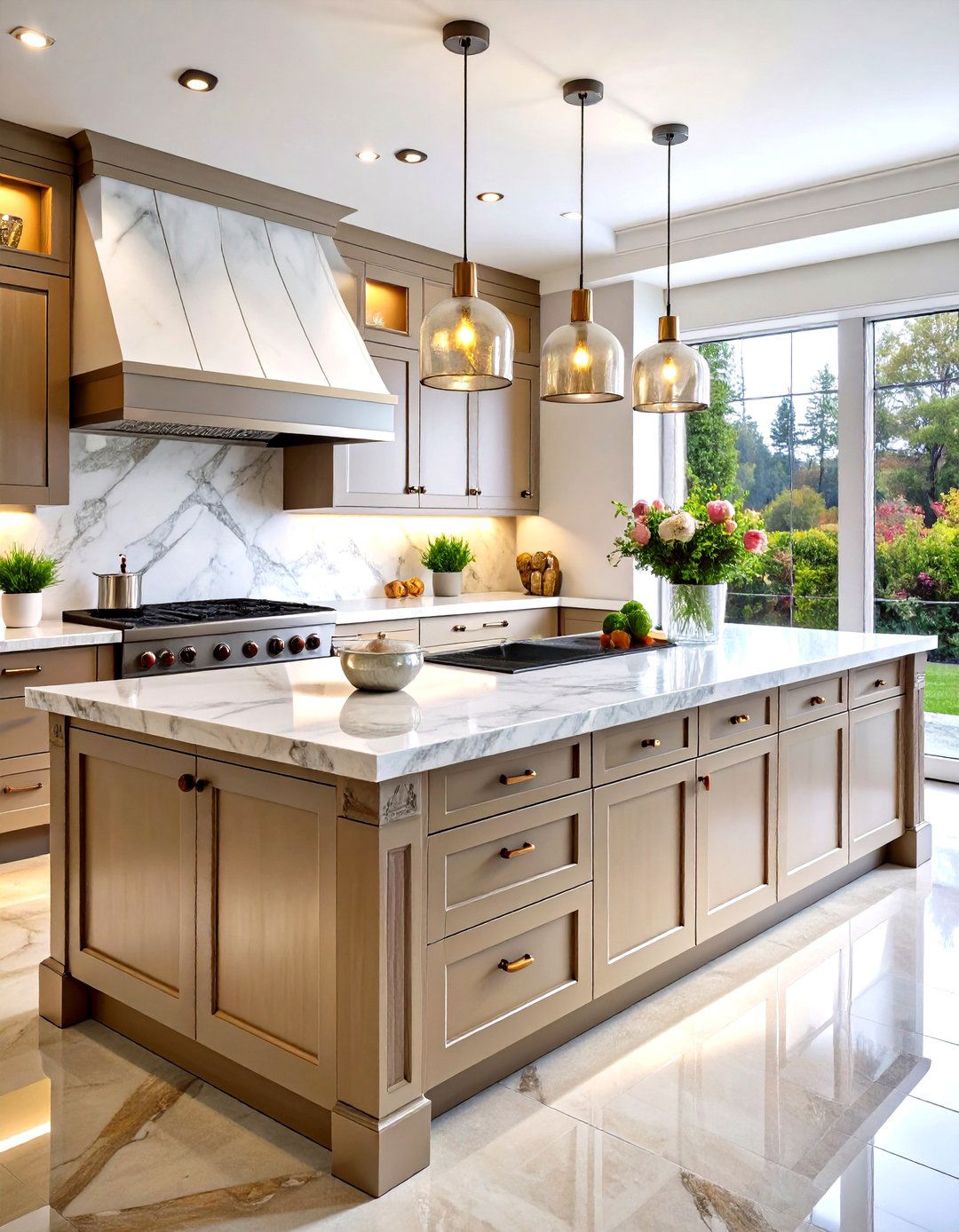
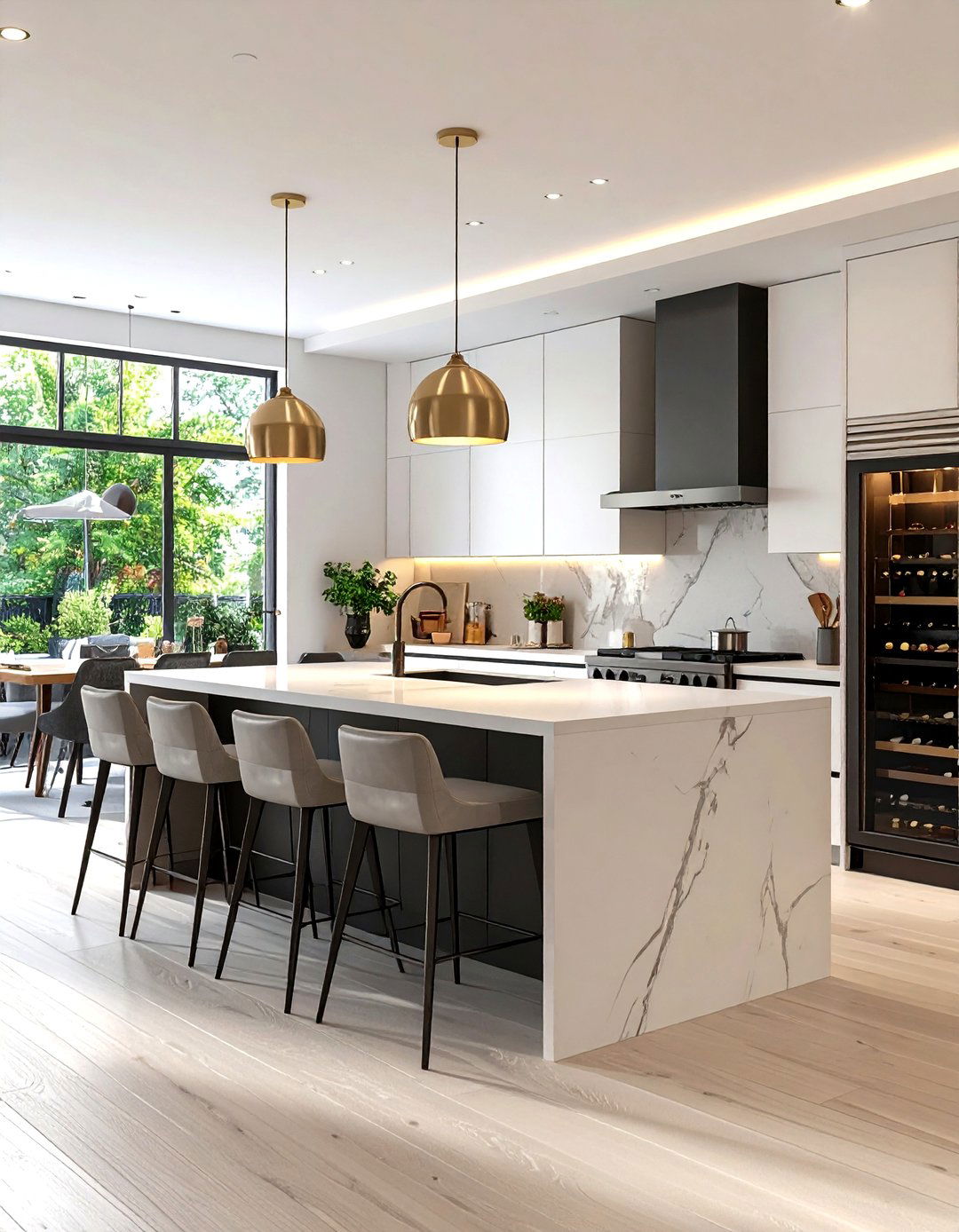
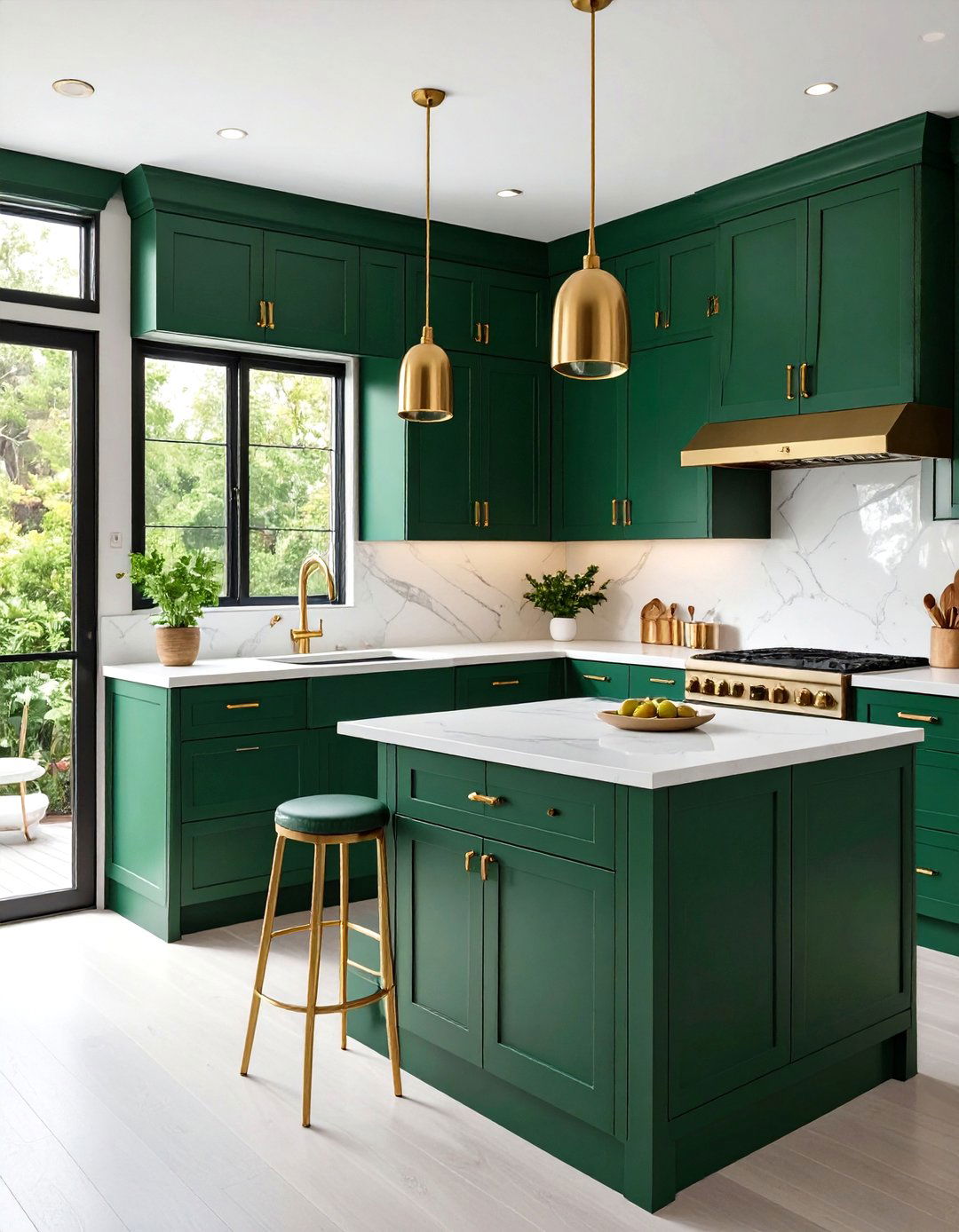

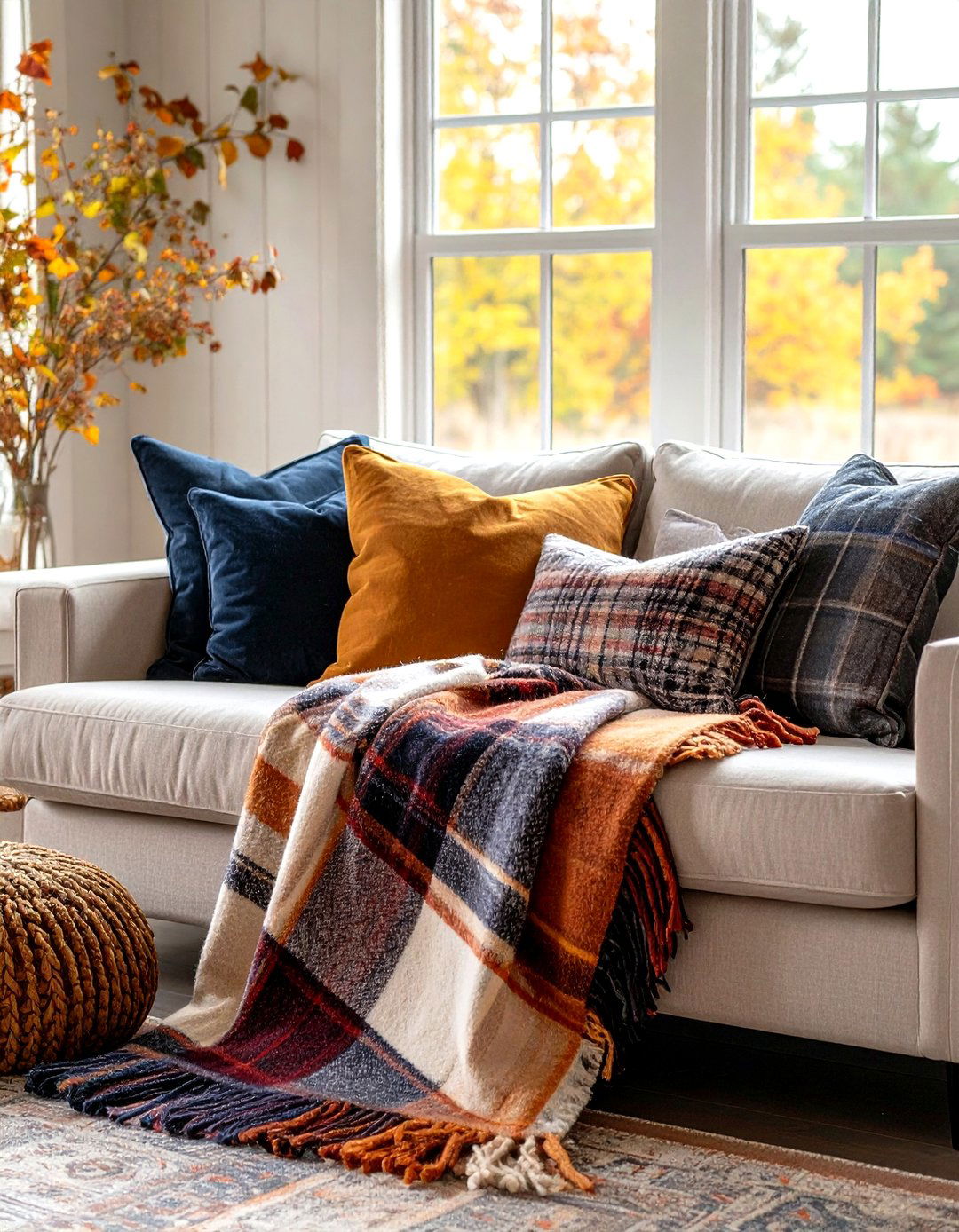
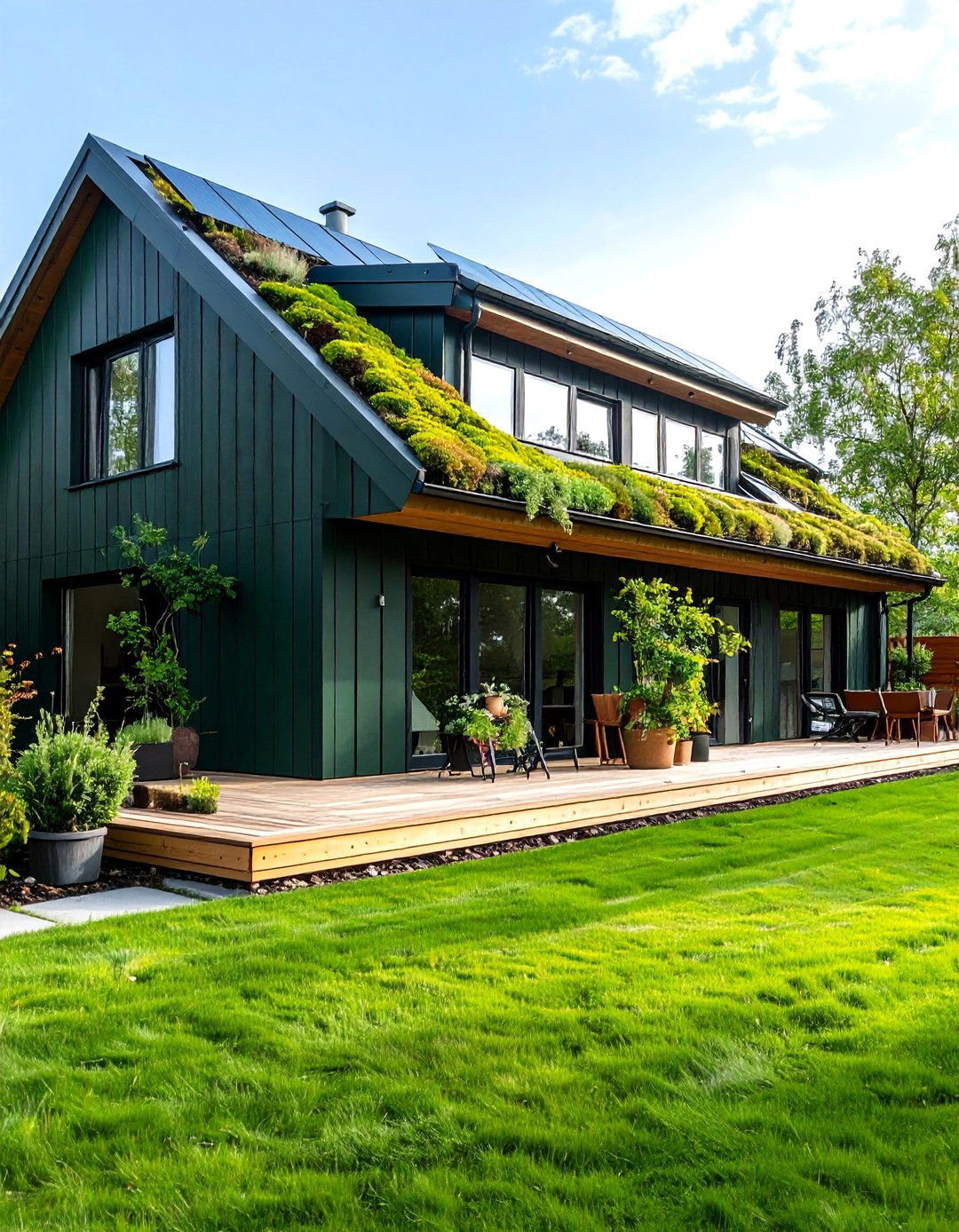

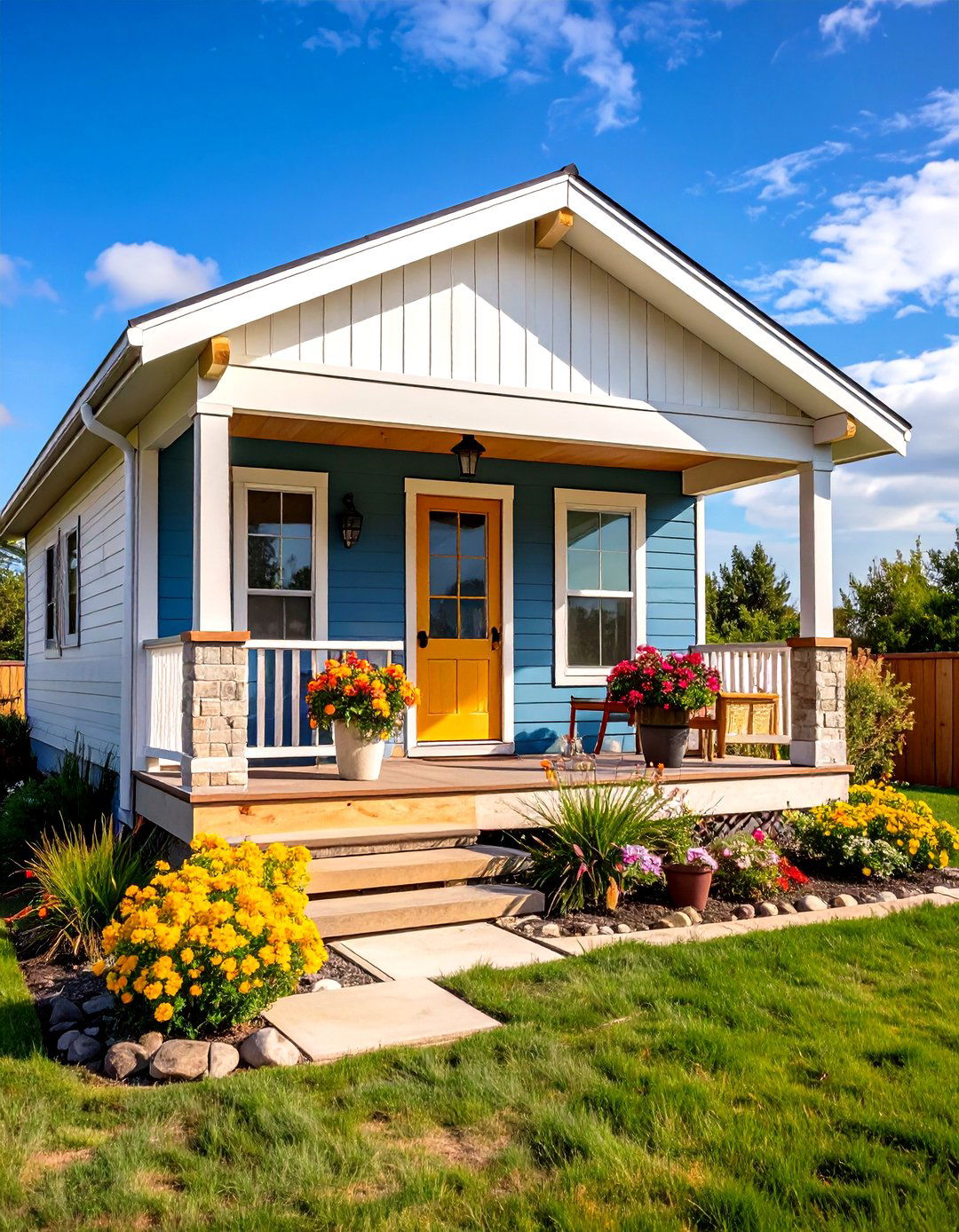
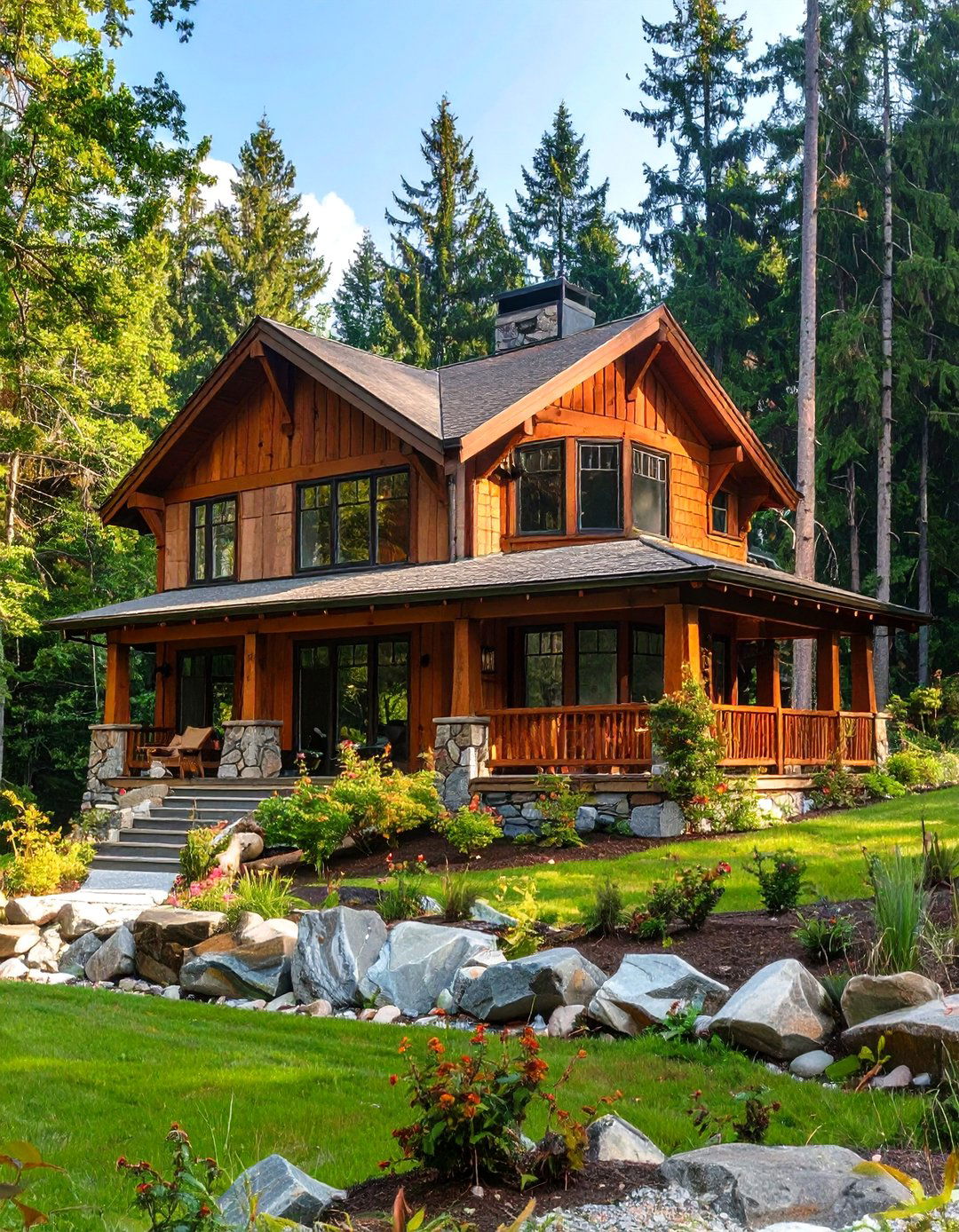

Leave a Reply